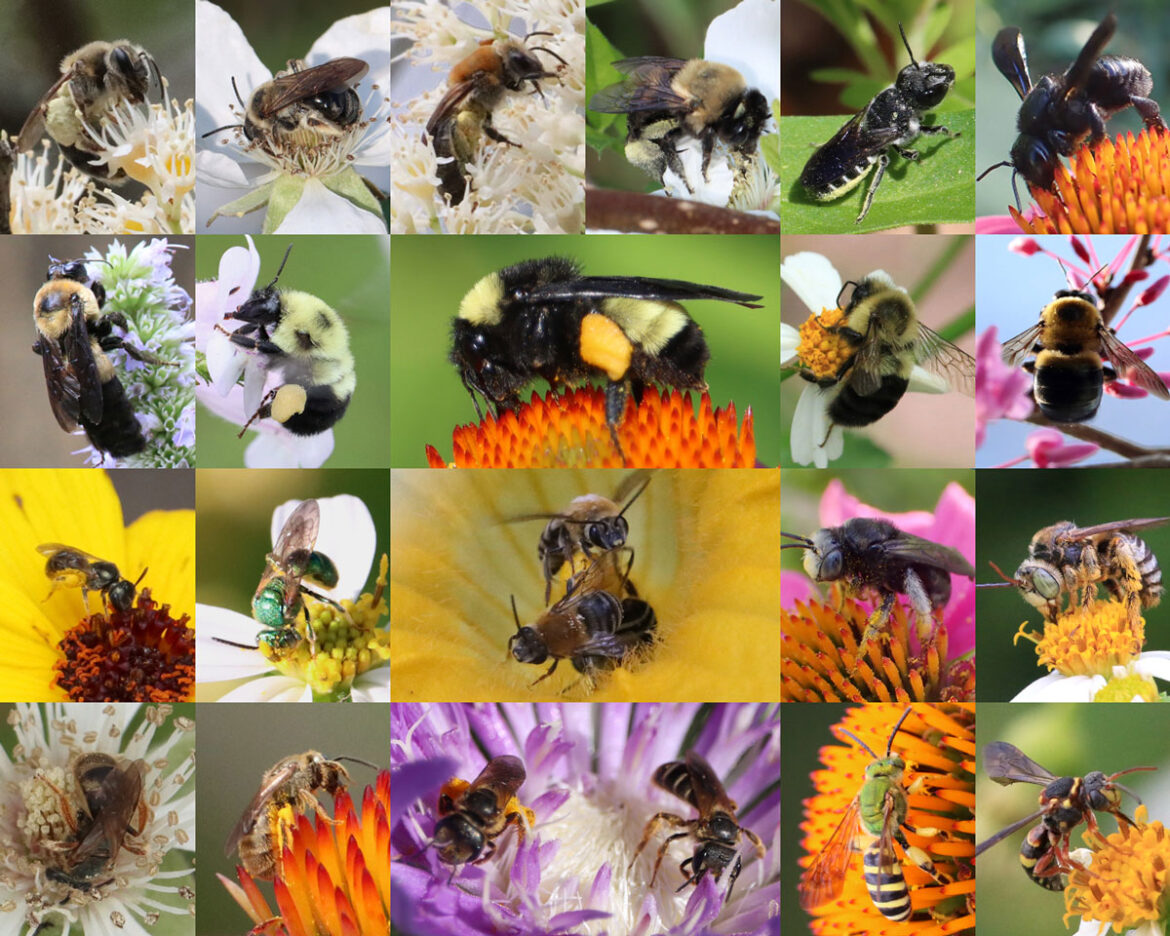This is a collection of bees I’ve photographed in my yard, mostly, as well as on shoots around our area. Florida has over 300 native species of bees, and there are over 500 in Georgia. This page will not list all of them! Instead, you’ll see the bees that might commonly visit our yards, and maybe a couple that are less common. I’ll keep adding as I photograph new species, or witness interesting behaviors.
Even if you don’t see a photo of the specific bee you saw in your yard, maybe you’ll see the type. Sometimes, the best we can do is identify a genus of bees, or a tribe. Some bees need several detailed photos, or a microscope, to differentiate between related species. This page organizes bees into their families. So you might be able to identify that you have a leafcutter or a sweat bee.
We’ve collected some information to help you attract bees to your home garden. Click to learn more about building a habitat through bee-friendly plants, space for nesting, and even a little water for them to drink.

Apidae
Carpenter Bees, bumblebees, longhorn bees, cuckoo bees, and honeybees
Carpenter Bees
Carpenter bees excavate their nests in dead wood, which, in our yards, can mean fences or any other (usually unfinished) wood structures in your yard. Understandably, some people regard them as pests. If you can tolerate a few perfectly round holes in a fence post, they are pollinators, and their nests are used by other pollinators as well.
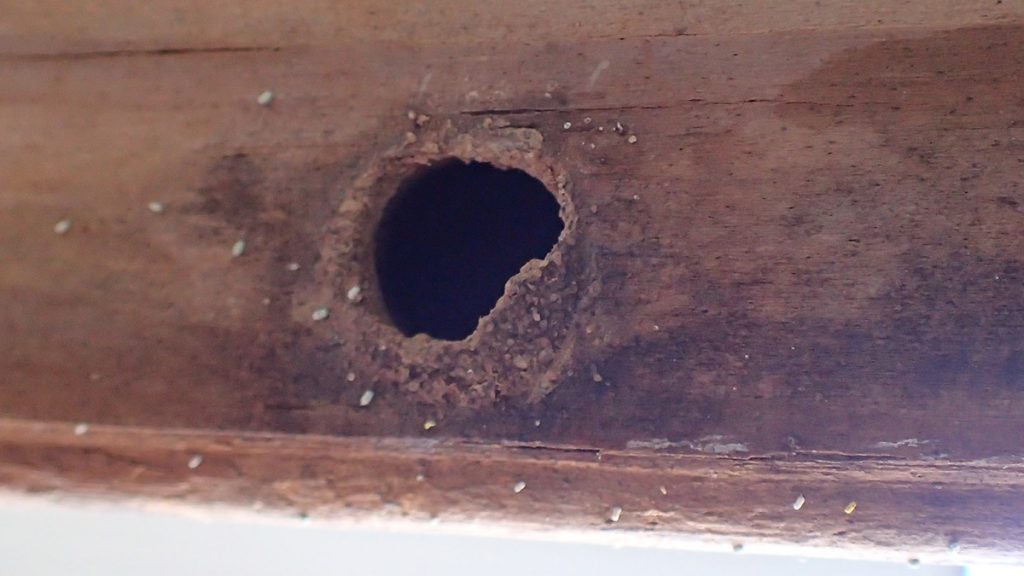
We talked to Dr. Rachel Mallinger, assistant professor of Entomology at the University of Florida, about Florida native bees, and she had a couple of things to say about carpenter bees. They do bore into wood, which concerns homeowners. Dr. Mallinger points out that carpenter bees nest in soft, usually decaying wood. The main structure of a house is constructed of hardwood, whereas trim, railings, and fences are made from soft wood. If the main structure isn’t decaying, carpenters may nest in the softwood structures.
Leaving decaying wood in brush piles, or otherwise incorporated into the landscape, offers an alternative nesting location for carpenter bees. Learn more in our post on helping nesting bees.
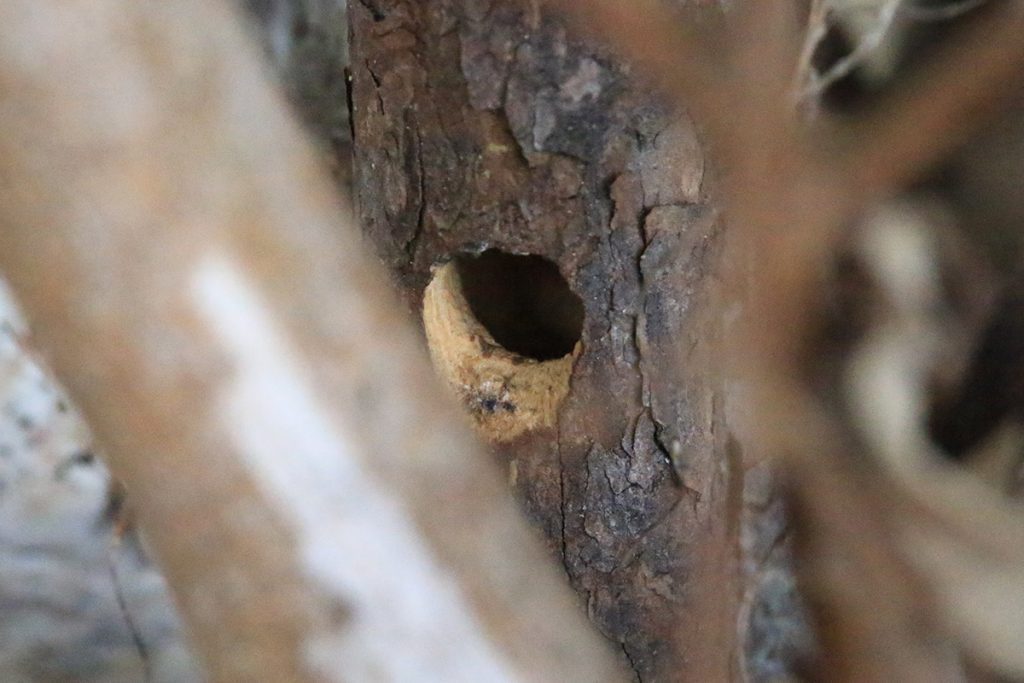
Dr. Mallinger also spoke about male carpenter bee’s tendency to fly at humans. It’s aggressive, and unsettling when they get in your face, but male carpenter bees have no stinger.
One last note about carpenter bees. They look, at first, like large bumblebees. The easiest way to differentiate between the two is the abdomen. As I tell the kids, bumblebees have fuzzy “butts,” whereas carpenter bees have smooth abdomens. But, as we’ll see below, there is one other bee species in the area that mimics carpenter bees and their “smooth butts.”
Eastern carpenter bee (Xylocopa virginica)
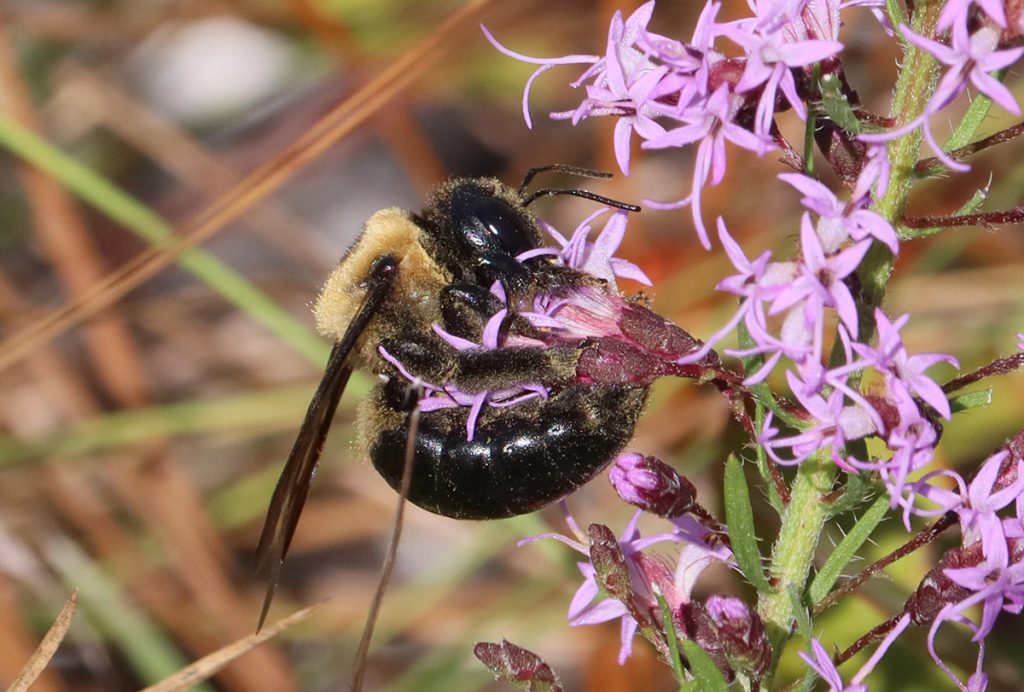
There are two species we’re likely to see in our area. The males of both species are similar, though the southern carpenter bee has a purplish abdomen while the eastern is pure black.
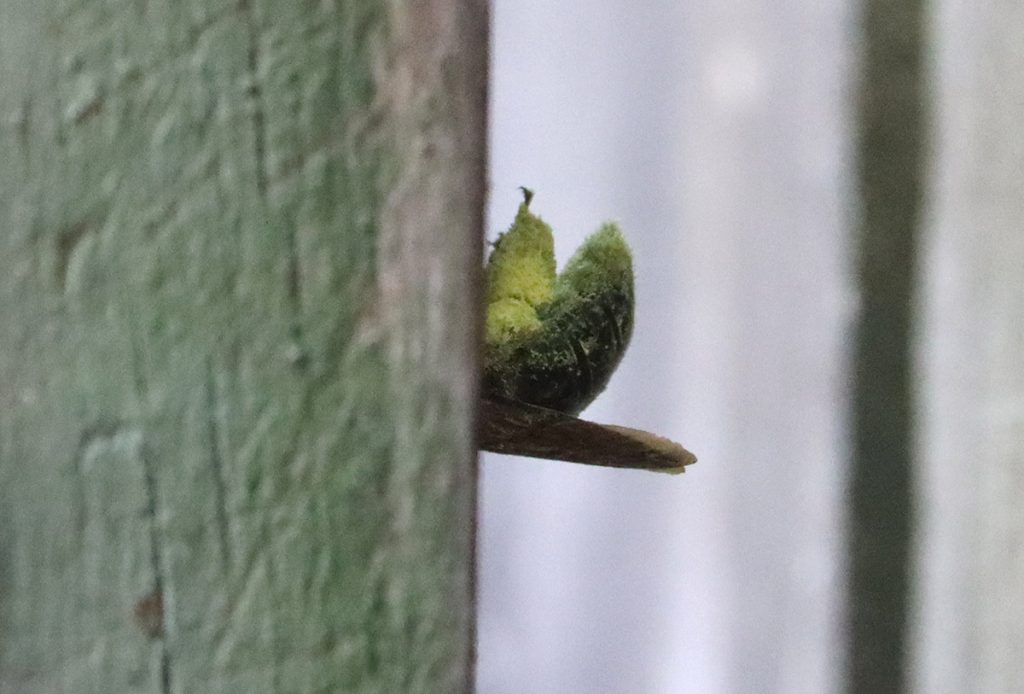
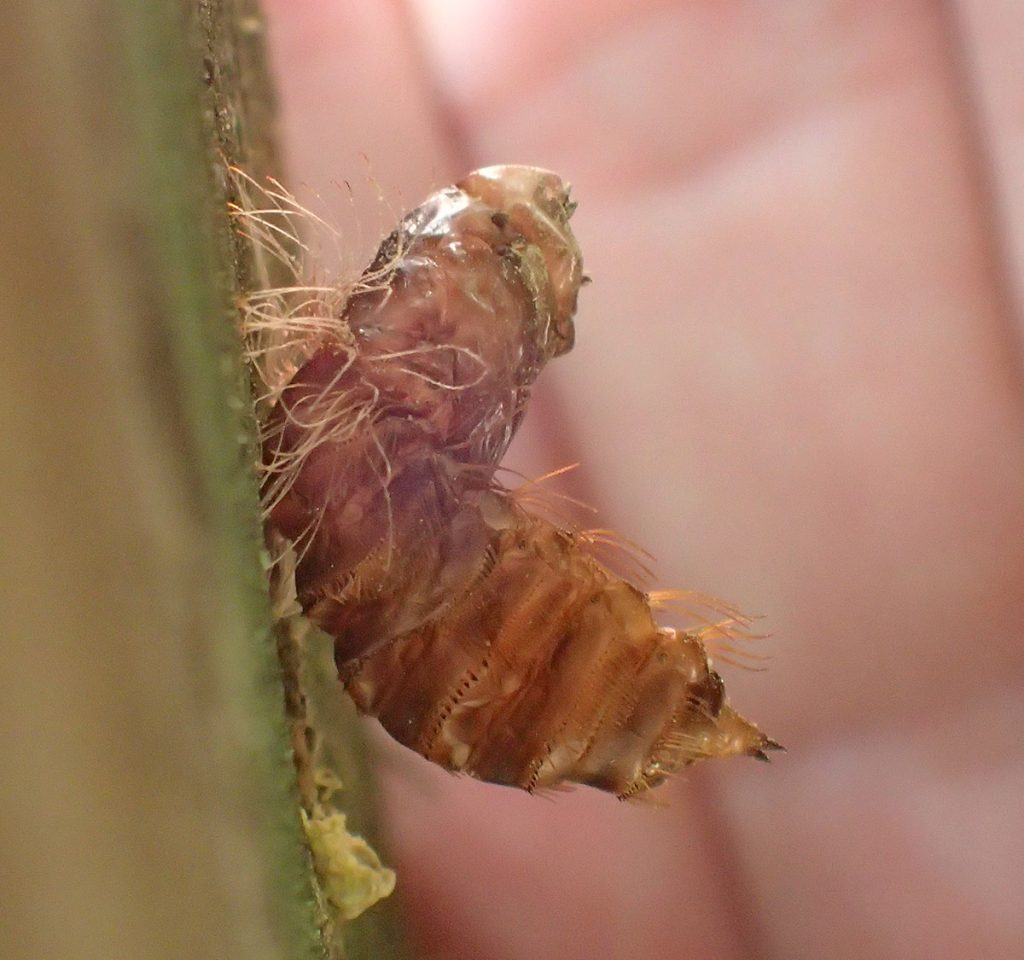
Southern Carpenter Bee (Xylocopa micans)
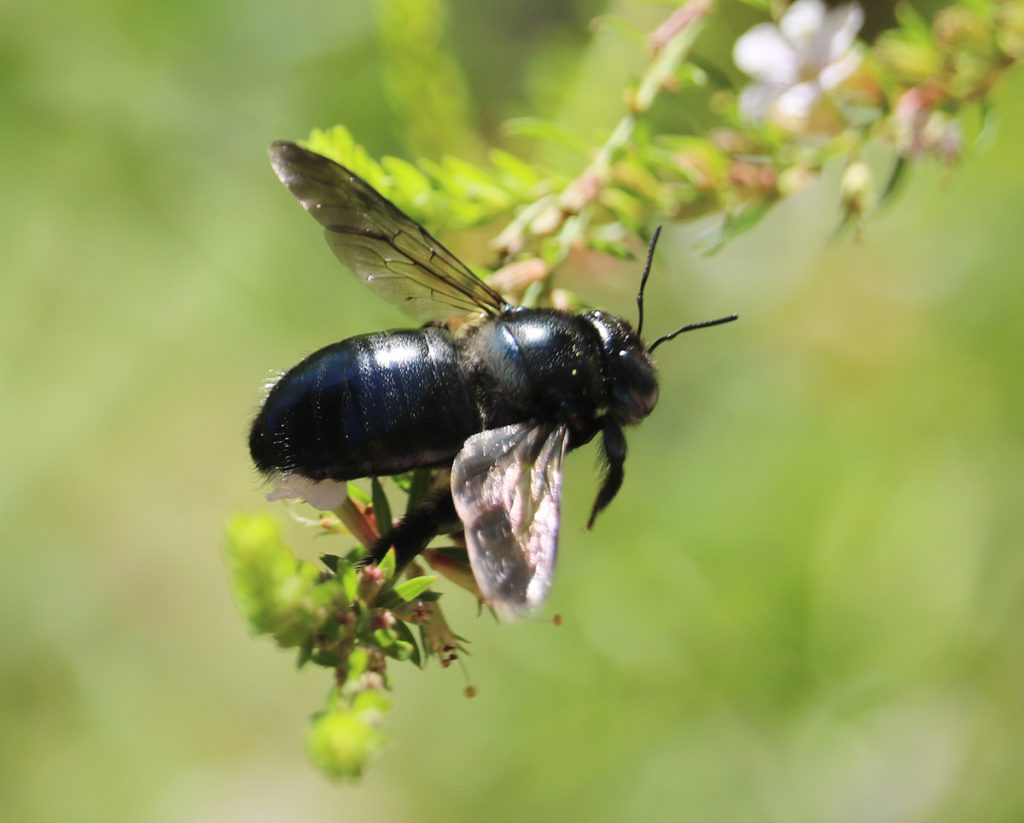
Here we see the female southern carpenter bee, which is all black with a purplish tinge. Female eastern carpenter bees, on the other hand, look much like their males.
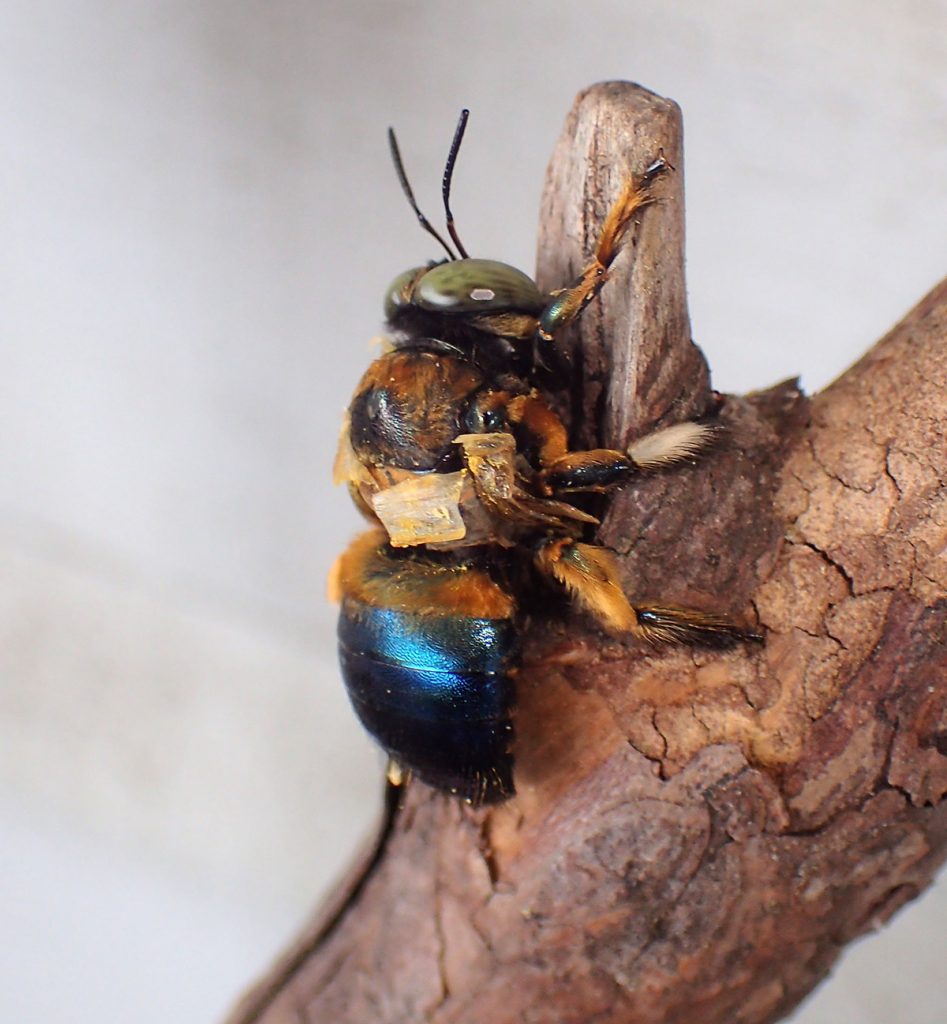
Bumblebees
Bumblebees are both common and conspicuous among our native bees. Not only are they widespread, but are large enough to be noticed even on higher-up tree flowers.
They are social bees. In the fall, queens and males leave the nest and mate. The queen is the only bumblebee to survive through the winter, carrying next year’s colony within her as she lies dormant in leaf litter. In the spring, she emerges and creates a new colony. The leaves we let lie in the winter harbor numerous insects, such as dormant adults, larvae, and pupae.
Eastern Bumblebee (Bombus impatiens)
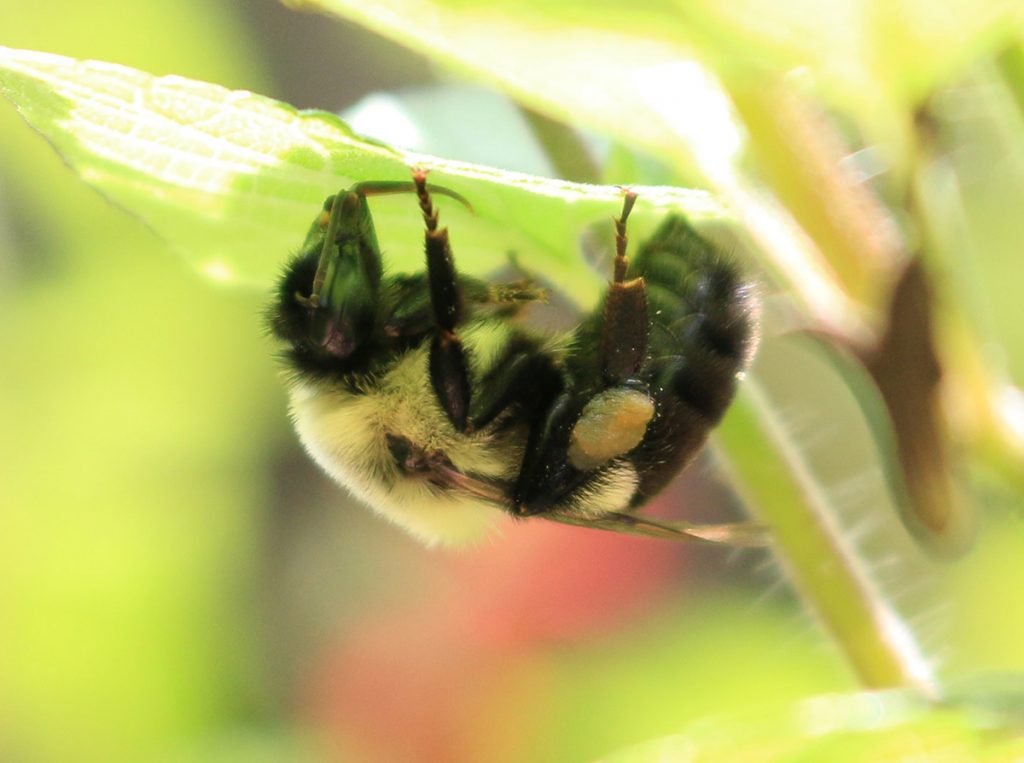
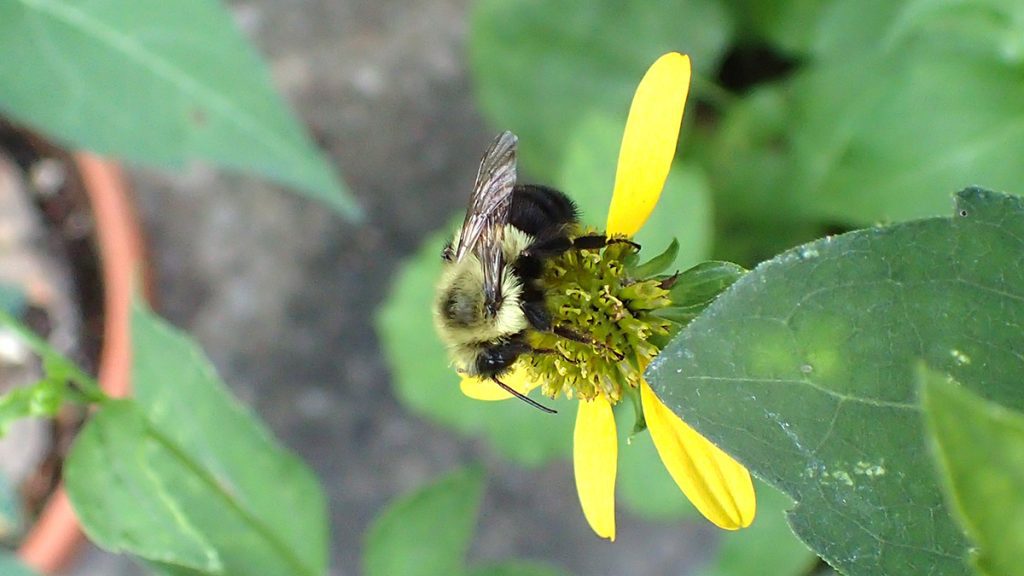
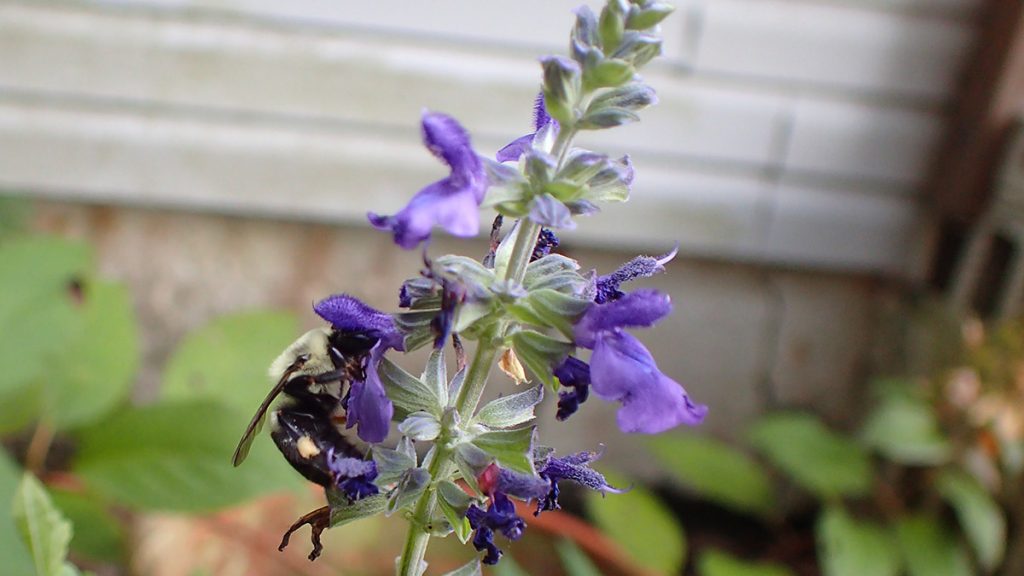
Here is the bumblebee species you’re most likely to see in your north Florida yard. It’s a ground-nesting species, where the American bumblebee nests above ground.
Note the fuzzy abdomen and pollen sacs on the hindmost legs.
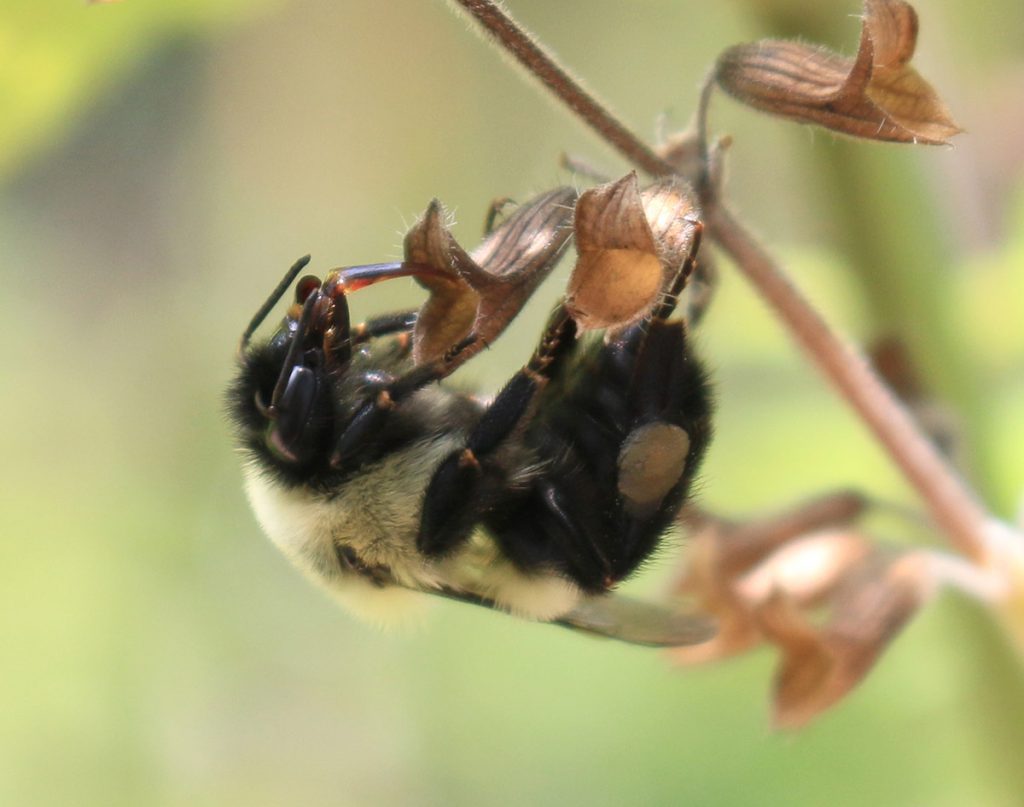
American bumblebee (Bombus pensylvanicus)
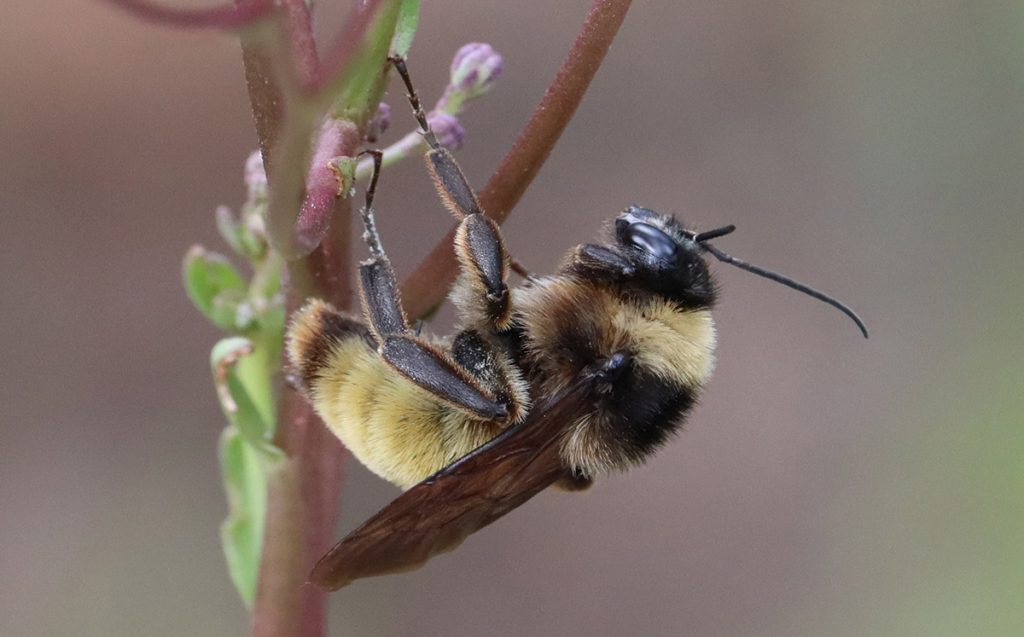
American bumblebees were once the most common bumblebee species in the US. But they have declined over the last several decades, and are now federally listed as Vulnerable. Unlike other bumblebees, they nest above ground. In our segment on them last year, they had taken over a purple martin gourd.
They are larger than eastern bumblebees, and have a striped yellow patch on their abdomens.
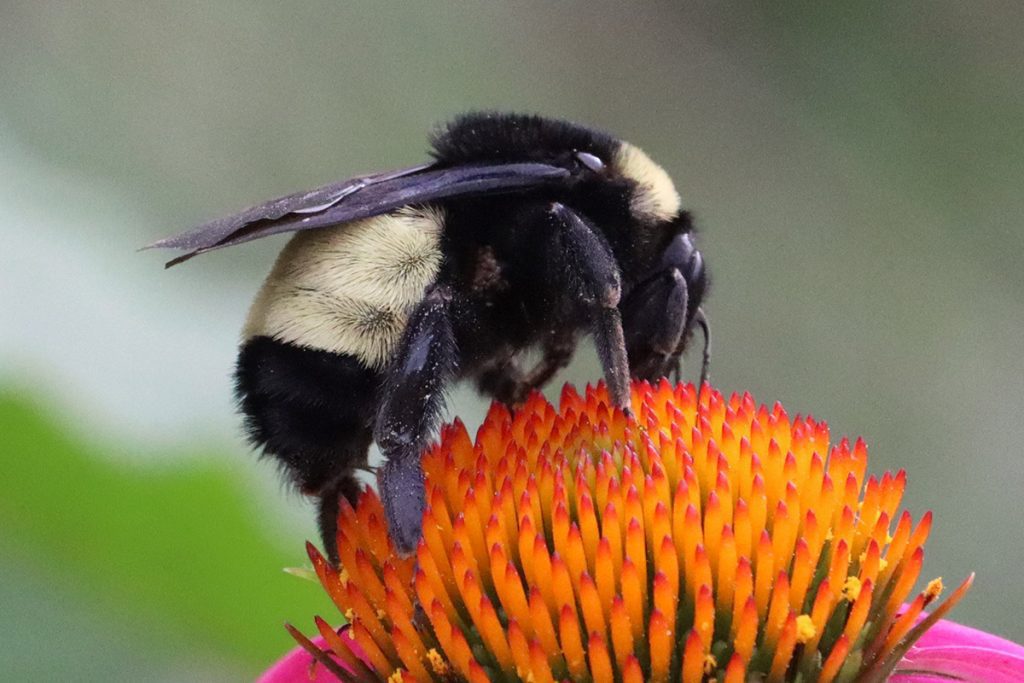
The American Bumblebee in the WFSU Ecology Blog
In August 2019, we visited a beekeeper who had taken in an American bumblebee nest.
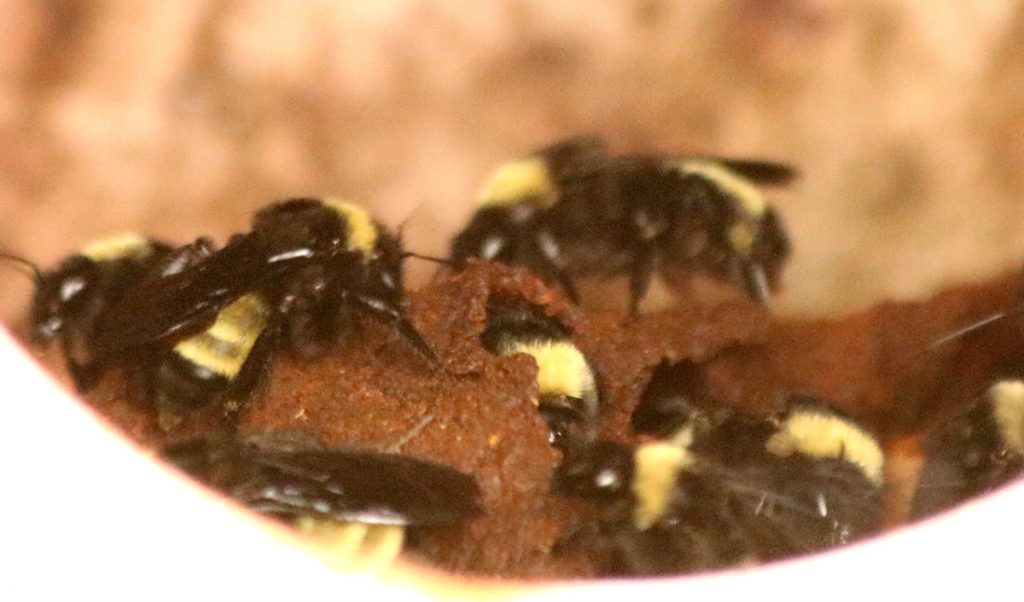
Southern plains bumblebee (Bombus fraternus)
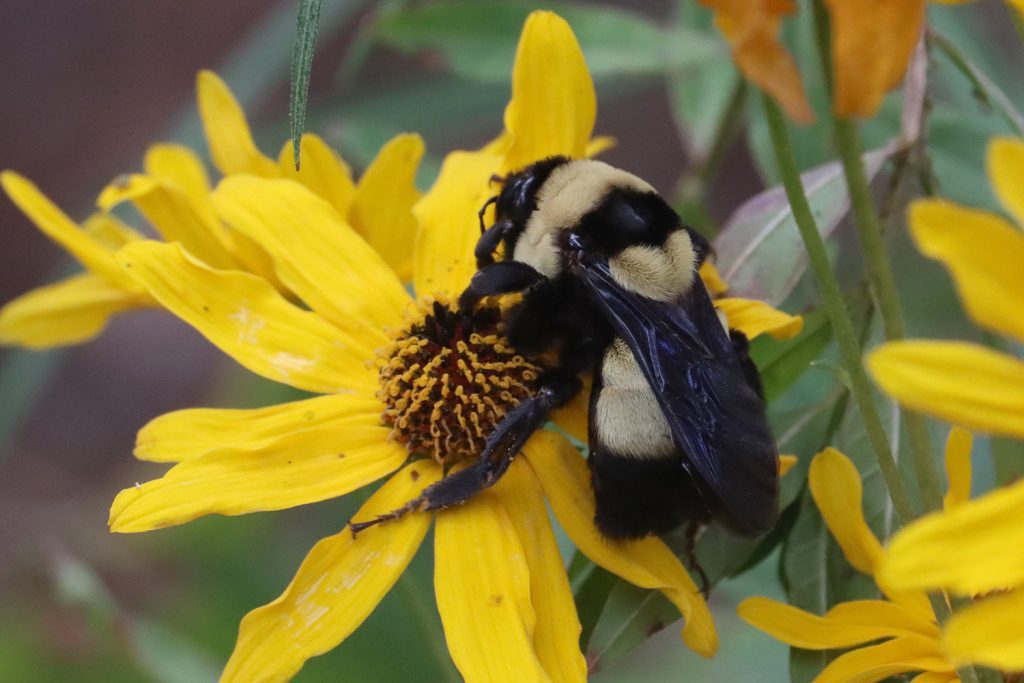
Here’s a large bee that briefly visited our yard in October of 2022. The southern plains bumblebee has been listed as globally endangered by the IUCN after drastic declines in its population in recent decades. The Xerces Society predicts that if the species continues its current rate of decline, it could go extinct within 80-90 years.
This is a bumblebee that favors intact prairie habitat, though it has been found in urban habitats. I live near downtown Tallahassee, but perhaps enough of my neighbors have embraced bee-friendly landscaping practices to provide this bee a nearby place to nest and feed. I hope I see this species return to our yard.
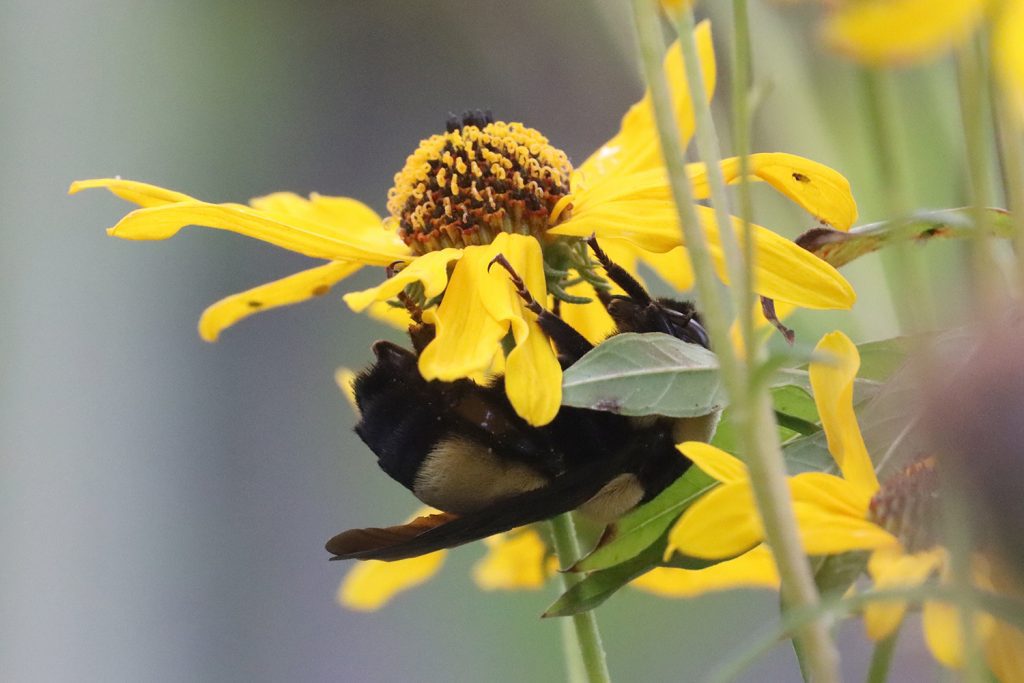
Two-spotted bumblebee (Bombus bimaculatus)
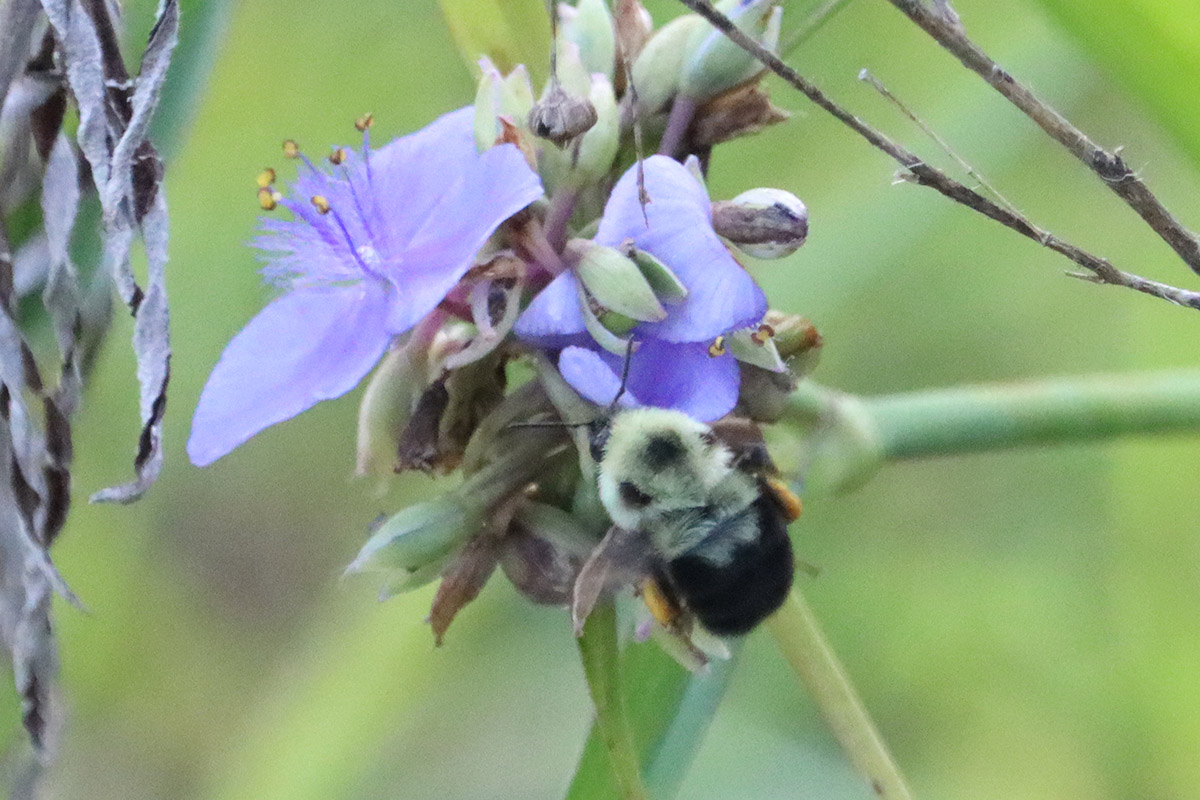
This bee is so named because of the “two spots” on its abdomen. To me, it looks like a yellow W on its otherwise black bottomside. It looks very much similar to the common eastern bumblebee, so when I see a bee that looks either I try to angle myself to see that marking.
The time of year might also help when differentiating the two bumblebees. From iNaturalist observations in Leon County, I see that this is a bee whose numbers spike in April and is rarely seen past June (throughout its whole range it spikes in July). They are also far less numerous than common eastern bumblebees, whose numbers climb until peaking in September/ October.
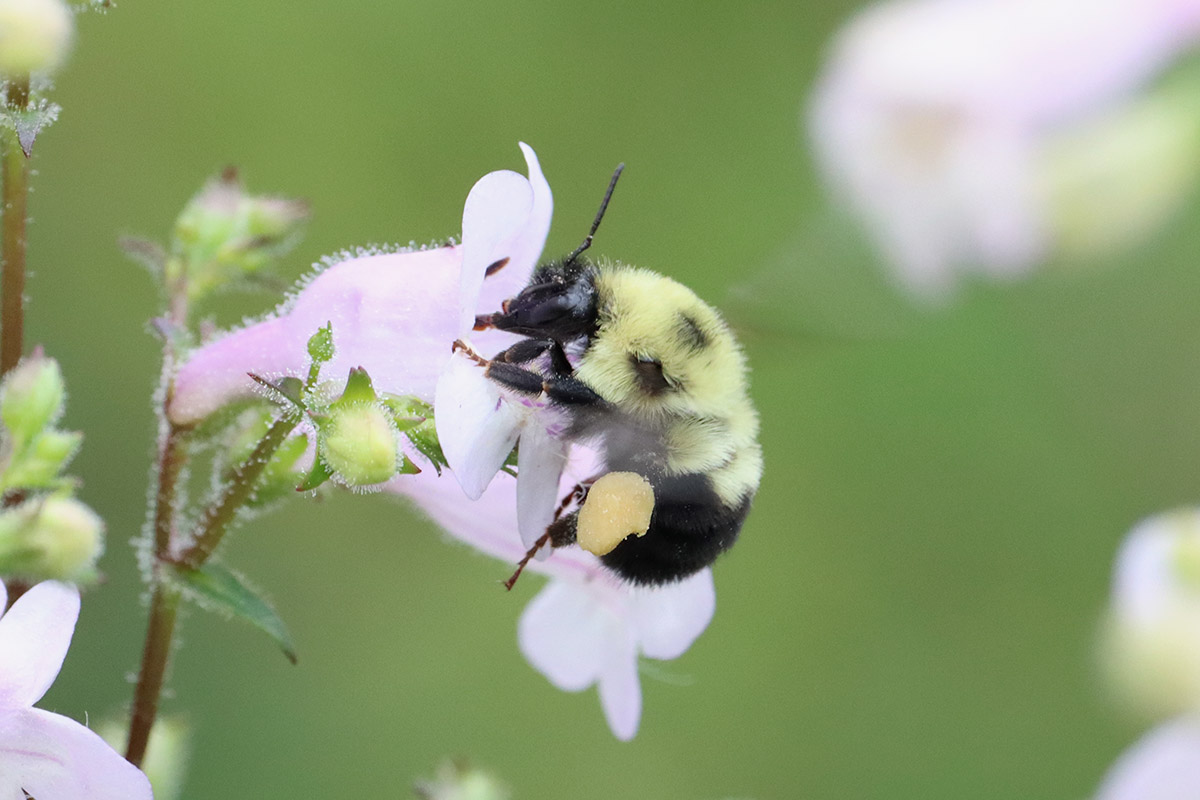
Longhorn Bees
Two-spotted long-horned bee (Melissodes bimaculatus)
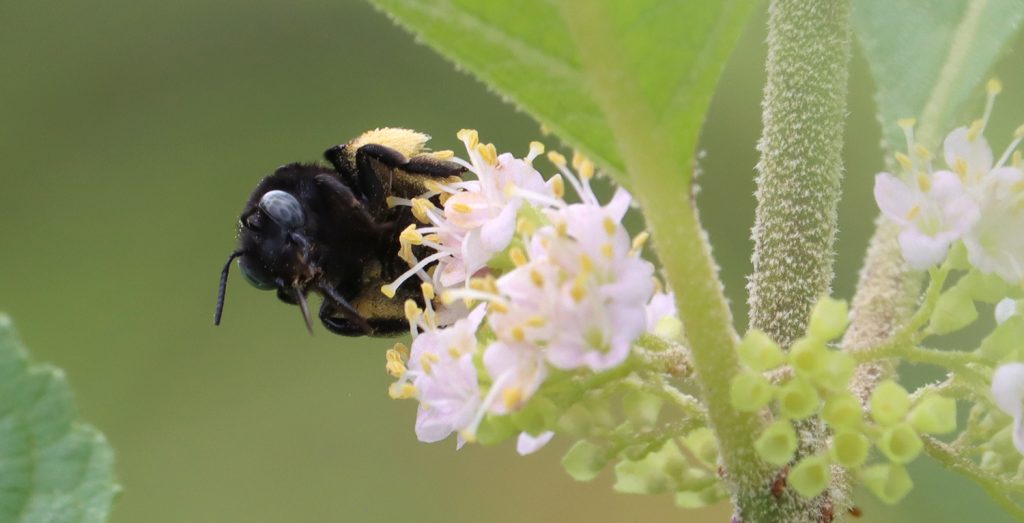
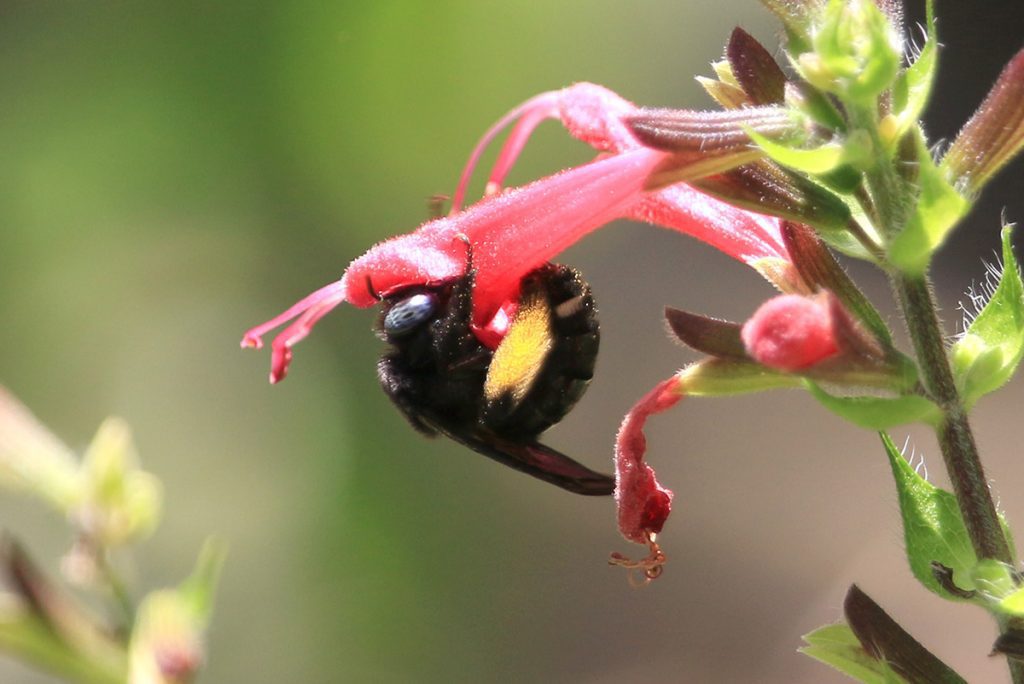
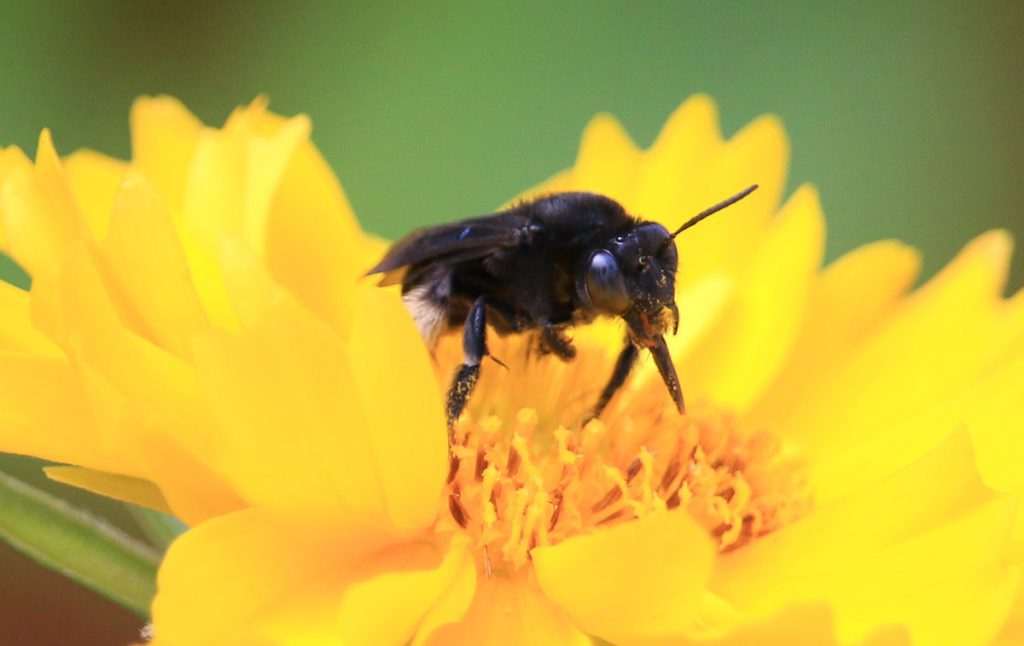
This is a bee I see in my yard from mid-May through early July. It feeds off a large variety of flowers of different shapes and sizes, hanging from salvia, pentas, or fanpetal flowers, or sitting on larger tickseed and coneflower flowers. And it loves beautyberry flowers. This generalist diet might account, in part, for their wide range as a species, covering half of the United States.
In 2023, I started seeing two-spotted longhorns in April. As there were no iNaturalist observations for it in April in Leon County, I added it. Those observations add data on seasonality and range that might be helpful to researchers. In 2023 I also saw a male for the first time. It looks like it has a blonde dye job on its head and legs:
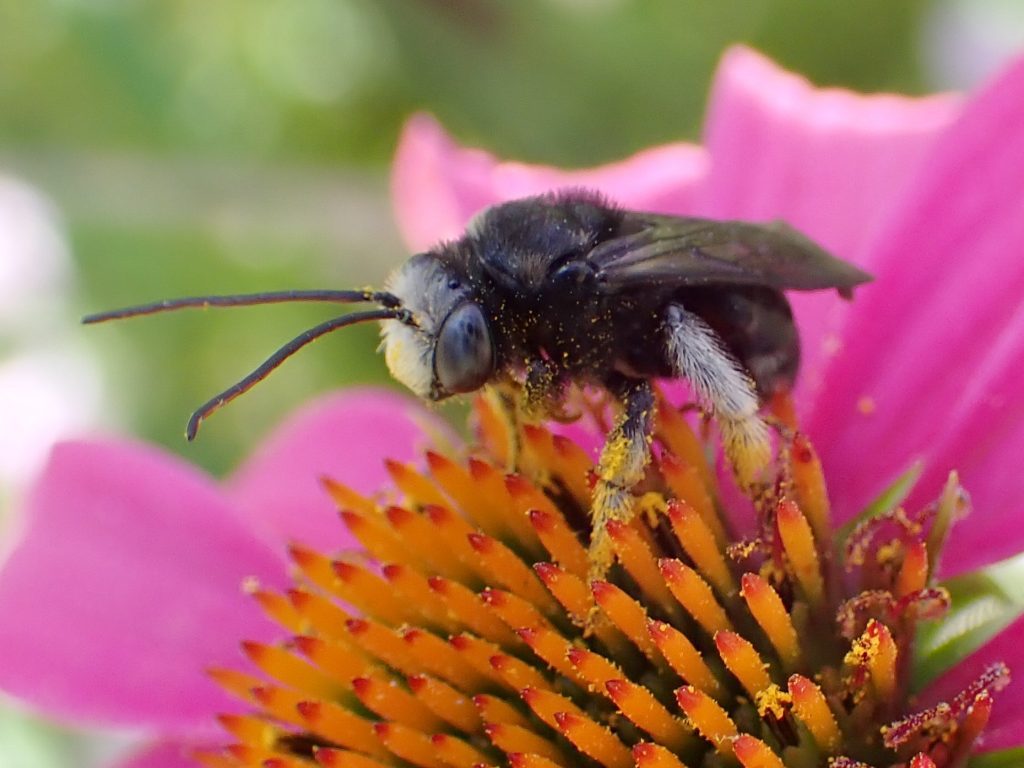
Svastra genus, subgenus Epimelissodes
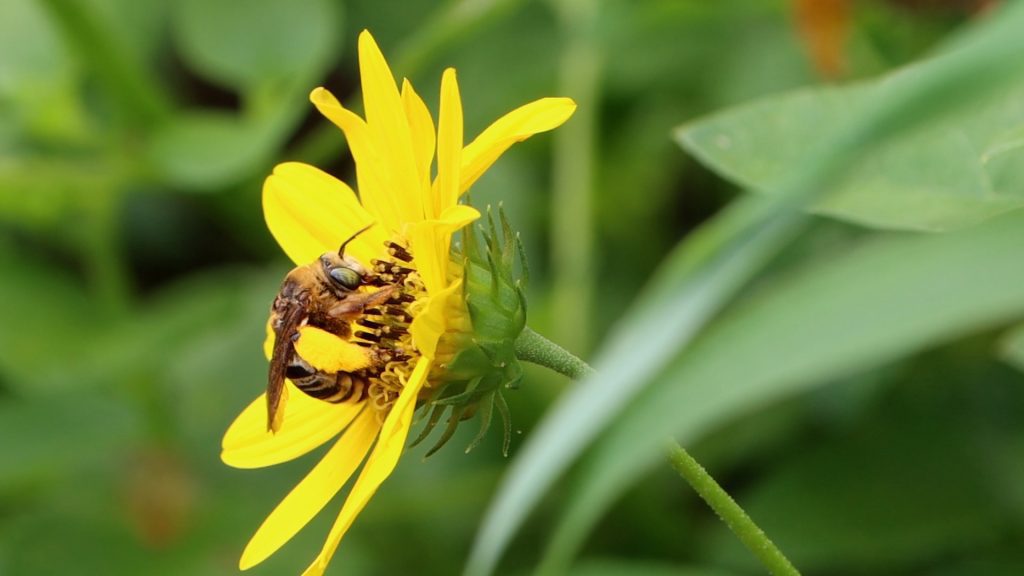
I’m pretty sure that both the bee above is Svastra, possibly Svastra aegis, the sandhills longhorn. I’m in doubt about the one below, it might be a Svastra or a common longhorn (Melissodes communis). These and a couple of other longhorns in our area look similar.
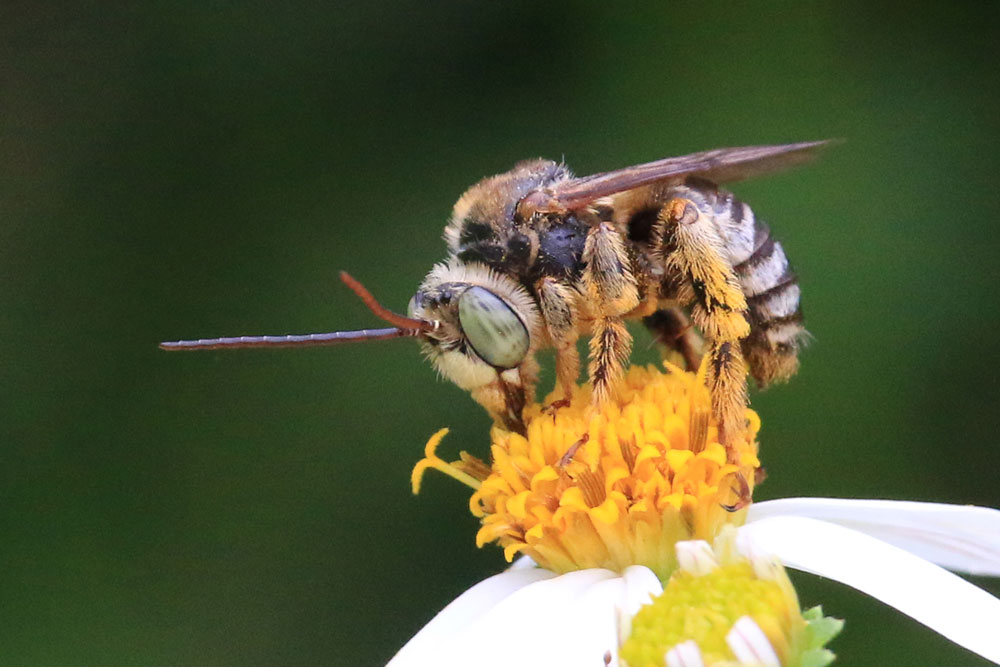
Pruinose squash bee (Peponapis pruinosa)
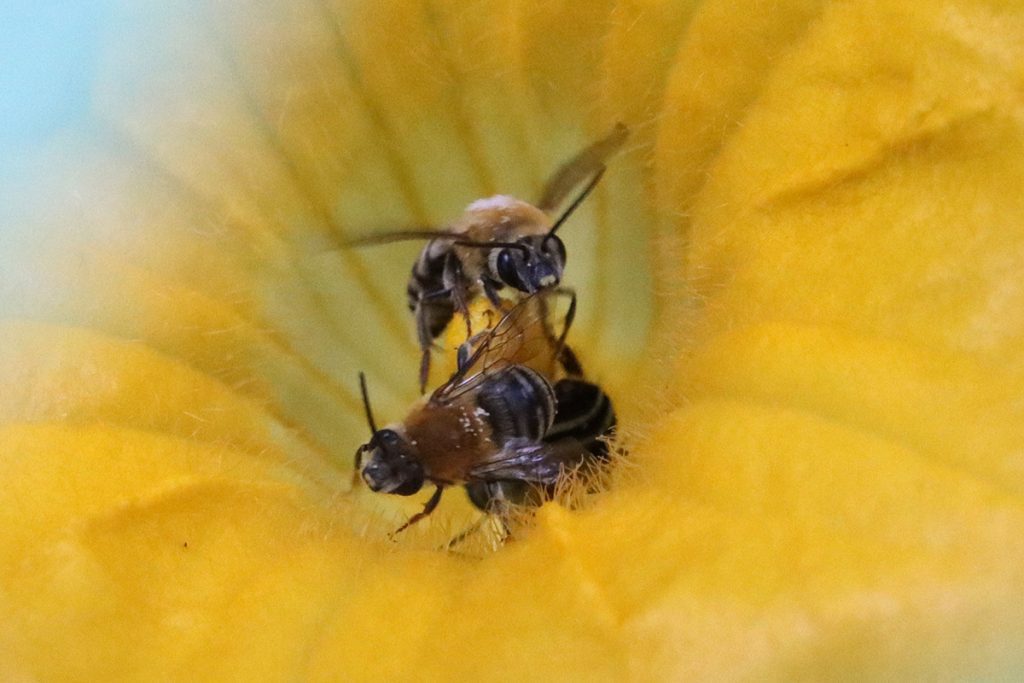
Like the blueberry digger bee, this is a specialist, though I’ve come to find that doesn’t mean they won’t try other flowers. The handful of squash bees observed in Leon County have all been found in May, but that’s a small sample size (half of those were mine from 2023). Throughout their range, they peak in July. I imagine its seasonality is tied to the availability of squash flowers in a particular area.
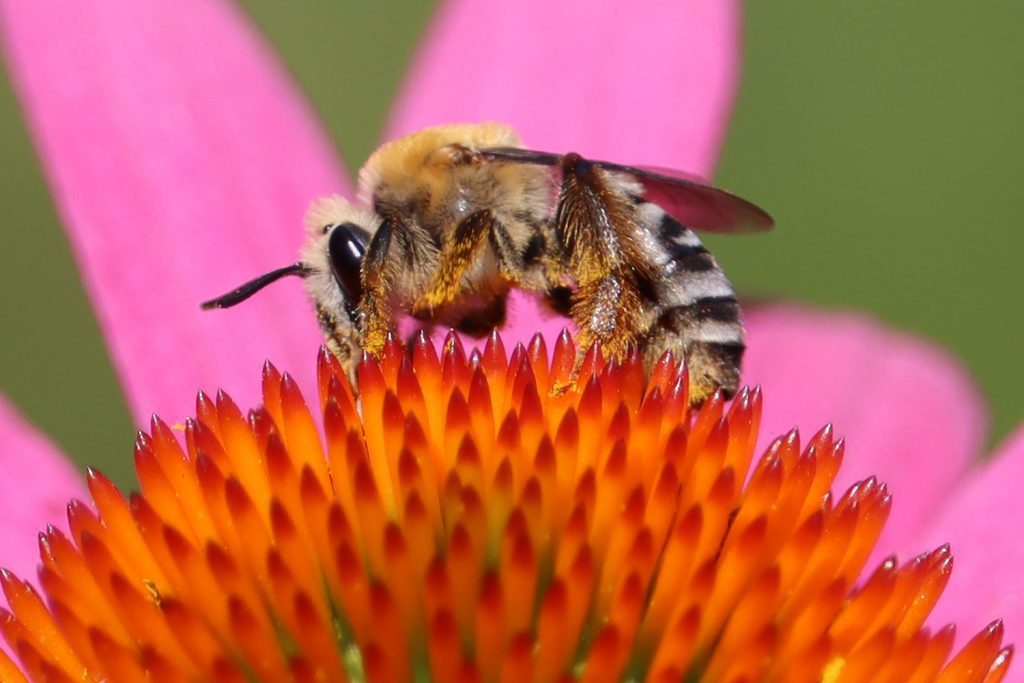
Cuckoo Bees (Apidae)
Cuckoo bees are kleptoparasites, animals that replace the eggs of another animal in the host animal’s nest. Their offspring hatch and eat the pollen collected by the host bee. Because cuckoo bees do not have to provision their own nests, they do not have pollen sacs.
Cuckoo bees have evolved in multiple families of bees, and typically target a specific genus, tribe, or family of bees. Directly below, we have a few species of cuckoo bees in the Apidae family. Scroll down further to find a cuckoo bee in the leafcutter family (Megachilidae).
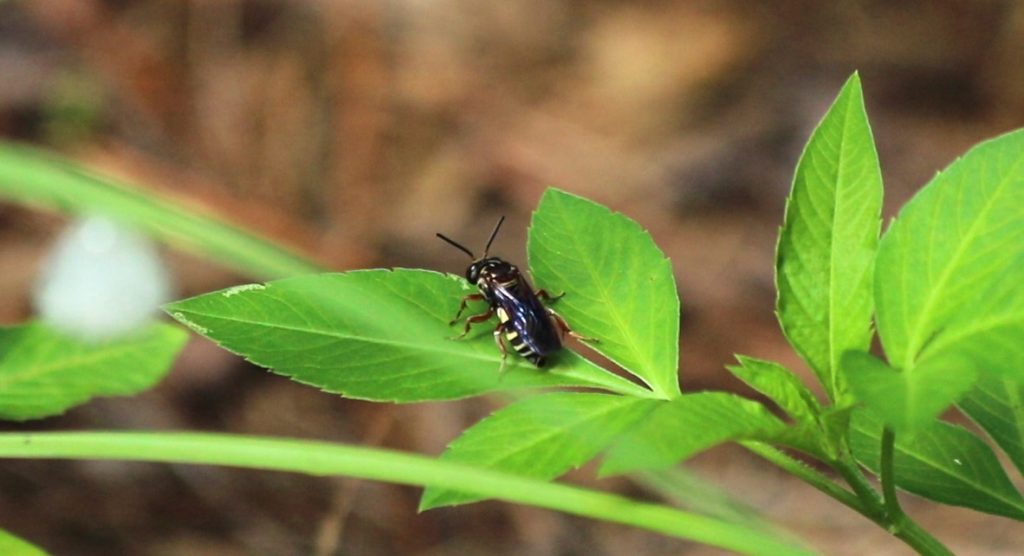
I observed the bee above in Klapp-Phipps Park, and Dr. John Ascher identified it as a member of the Triepeolus genus.
Lunate-longhorn cuckoo bee (Triepeolus lunatus)
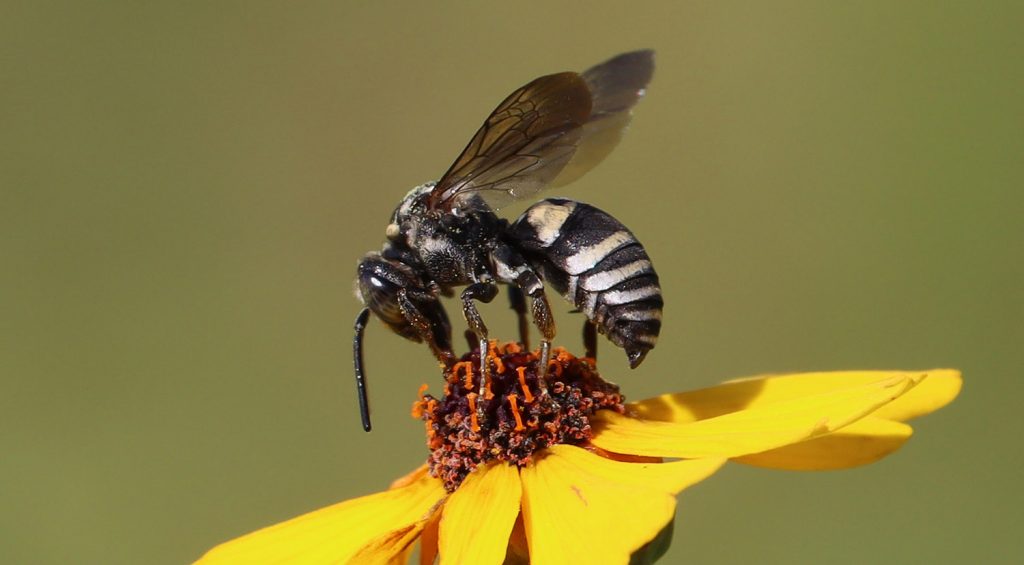
This cuckoo bee lays its eggs with those of the two-spotted longhorn bee, which is common in my yard from mid-May through early July. I only spotted this one once in my yard, in June of 2022, just as I was starting to see multiple longhorns.
Lively cuckoo bee, aka fervid nomad bee (Nomada fervida)
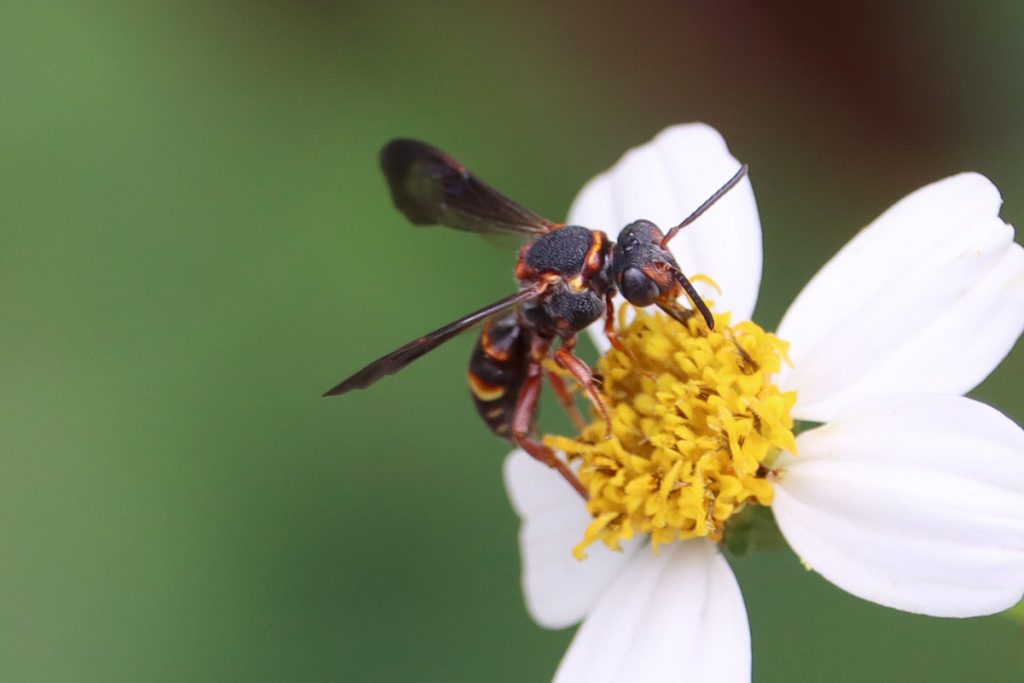
I first photographed this bee in our yard, in August 2020, and I’ve seen it every year since at about the same time of year. Cuckoo bees lay their eggs with specific bee species, genera, or families; this bee hosts on the Agapostemon genus. In our yard, this is represented by Agapostemon splendens– the brown-winged striped sweat bee. Those have an annual population explosion every August in our yard, when we see the fervid nomad bees that nested with them.
Digger Bees
Blueberry Digger Bee (Habropoda laboriosa)
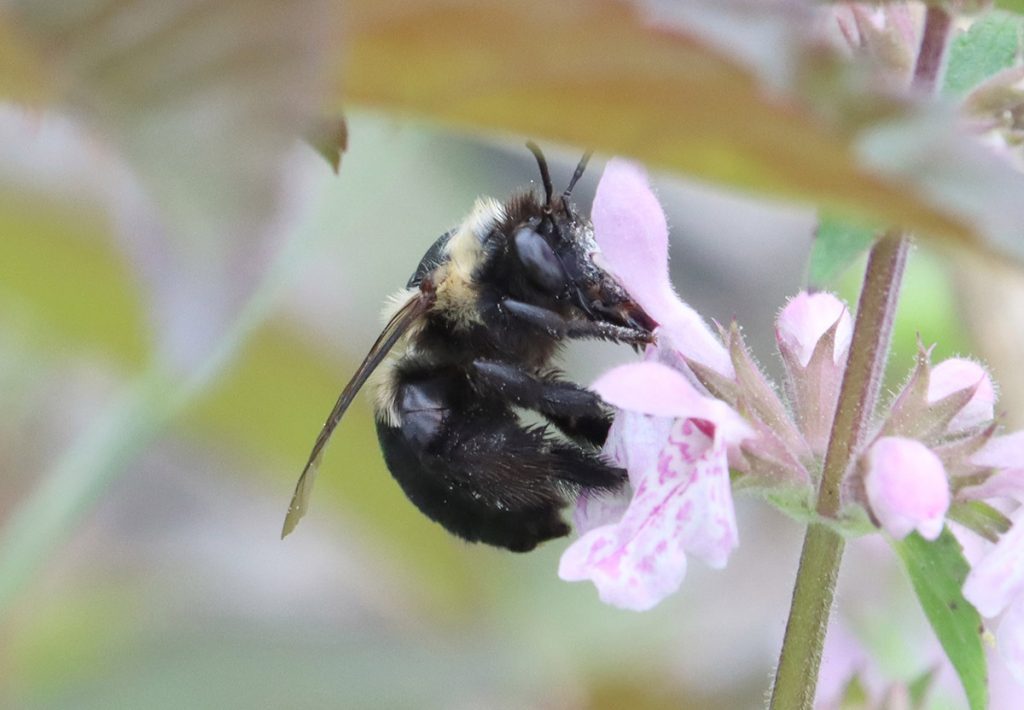
The blueberry digger is an early flying bee, coinciding with the spring bloom season for blueberry species in the southeast. It uses buzz pollination (sonication), vibrations that shake loose pollen. I first saw this one crawling into a ground nest, and later on blueberry flowers. In our yard, they like Florida betony (an early-blooming wildflower that grows as a weed) as much as they like blueberry flowers.
Fun fact- when Proof Brewery hosted WFSU and its partners for 2019’s EcoCitizen Day, it brewed a blueberry beer called Sonicated.
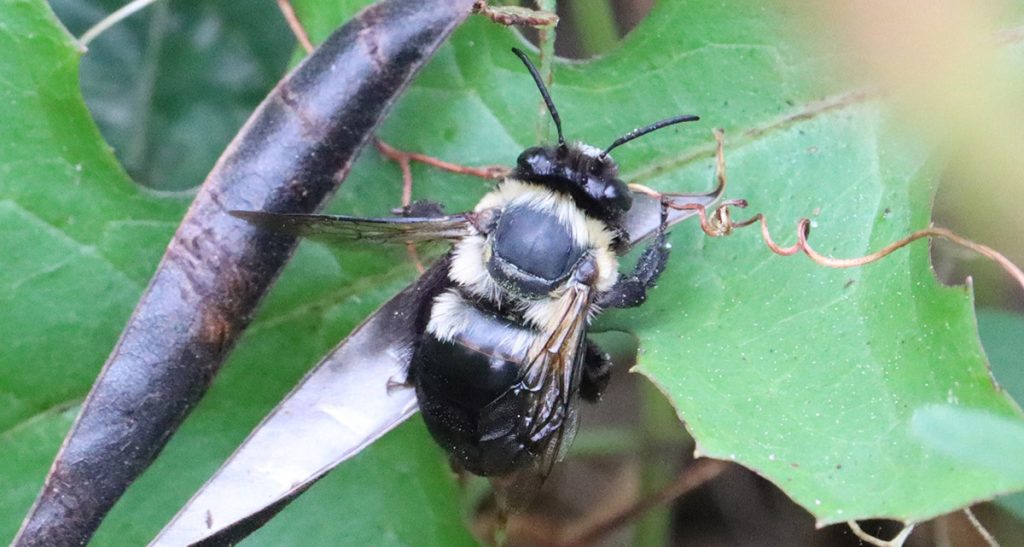
Western honeybee (Apis Mellifera)
I’ve saved these for last in this family because they’re not native, though they are an important agricultural animal. Below is the most common honeybee we might see, the female worker bee. During the weeks that they’re alive, they move through a series of jobs, from tending larvae to, finally, seeking nectar to bring back to the hive, from which they make honey.
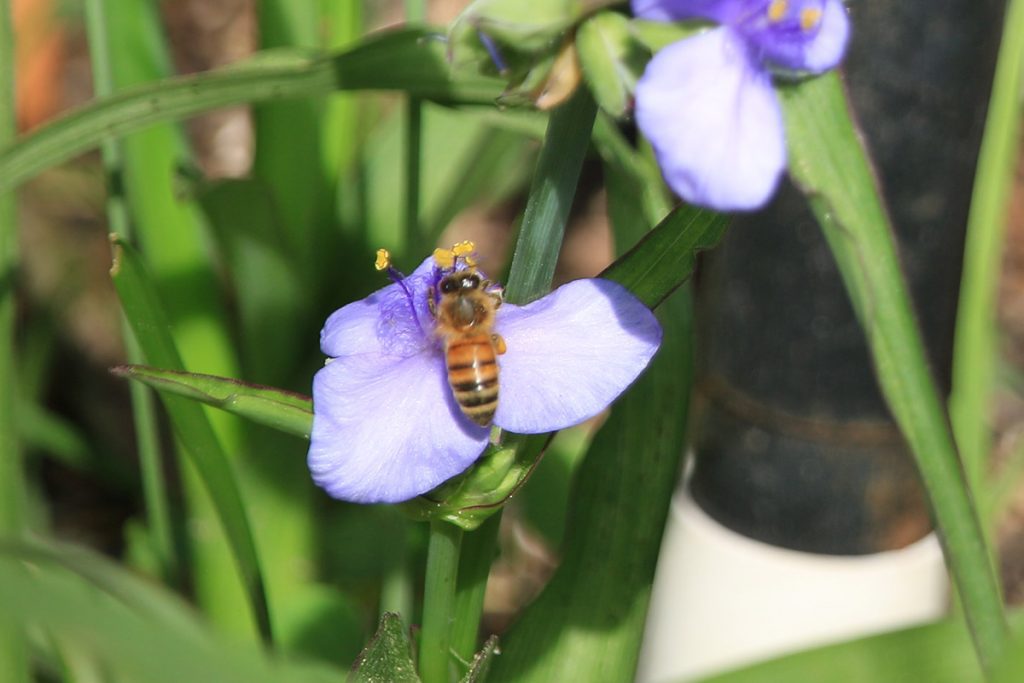
Below are the queen, the mother of all of the bees in the hive, and a drone. Drones are male bees and are distinguished by their larger eyes, which give them the vision they need to spot a queen in flight. Their only job is to find a queen and mate.
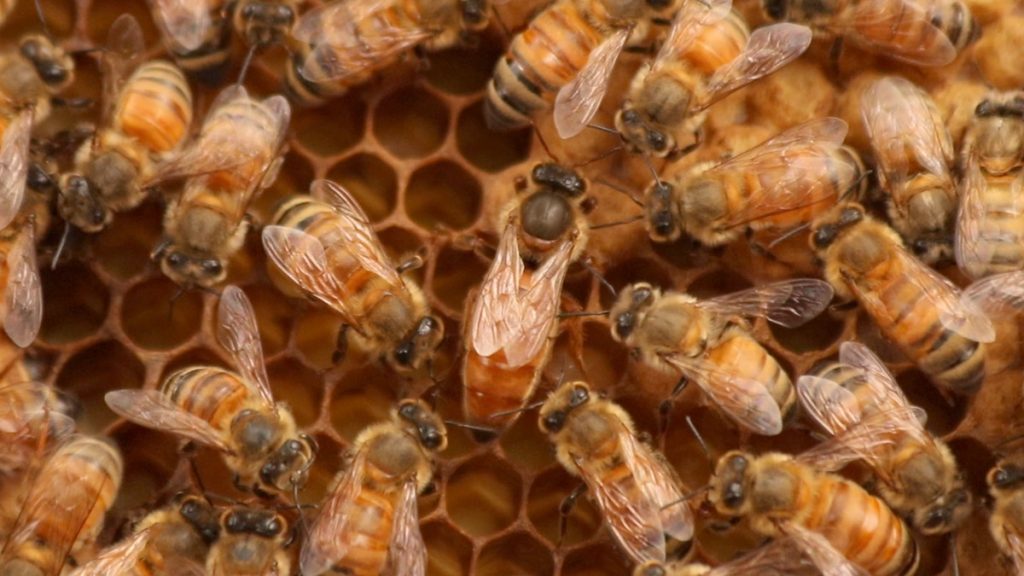
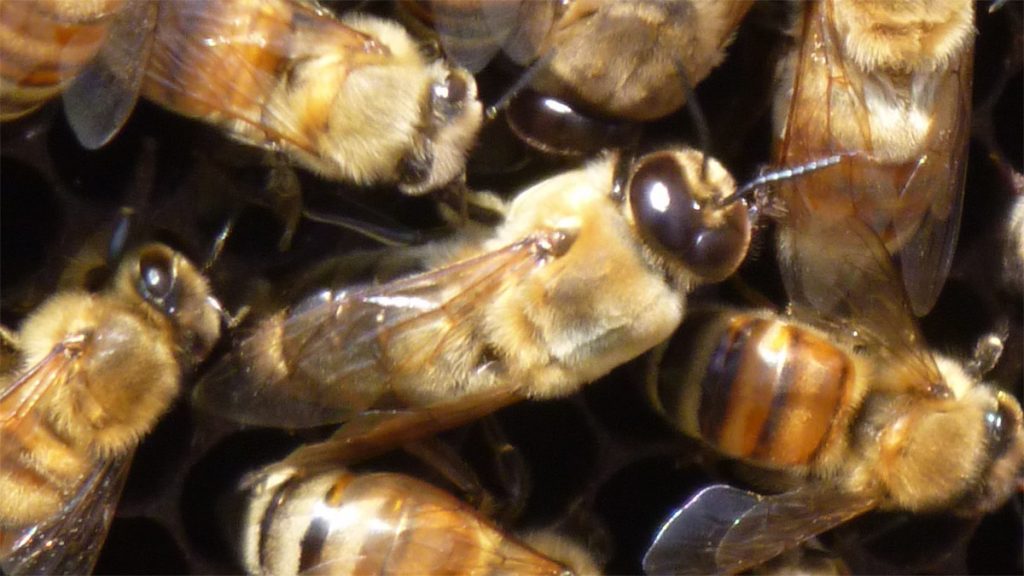
Honeybees build hexagonal cells in their hives. Some of those cells contain honey, and others larvae. Worker bees tend to the larvae until they’re almost ready to pupate (metamorphose into adults), and then the cells are capped. You can see larvae in the uncapped cells below.
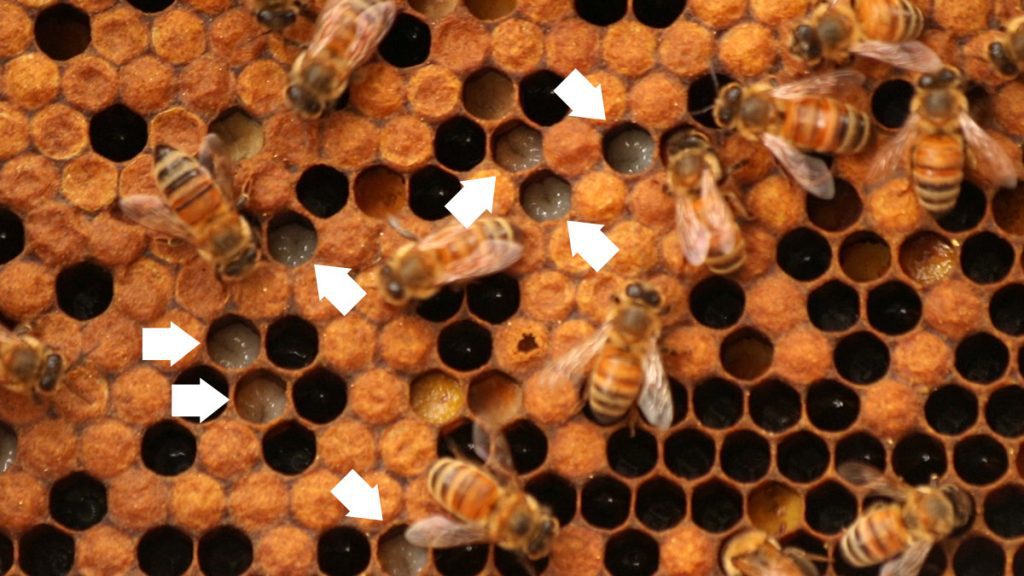
Honeybees on the Ecology Blog
- In 2014, we kayaked the Dead Lakes and visited apiaries in the Wewahitchka area. The numerous tupelo swamps between the Chipola and Apalachicola Rivers make this the tupelo honey capital of the world.
- In 2019, Dr. Lee Bushong and his partner, FAMU Entomology PhD. student Worrel Diedrick took us into their hives. All of the photos of honeybees are from that shoot. They were also raising an American bumblebee colony.

Megachilidae
Leafcutter, mason, and resin bees
This is a family of solitary nesting bees with similar habits. They make use of existing tunnel structures, such as those left by wood-boring beetles or insects that tunnel in the ground. Leaf cutters will, as their name suggests, cut leaves to line these tunnels and build their nests. Mason bees collect sediment to seal their tunnels, much like mason wasps. Resin bees use resin to seal their nests.
Carpenter-mimic leafcutter bee (Megachile xylocopoides)
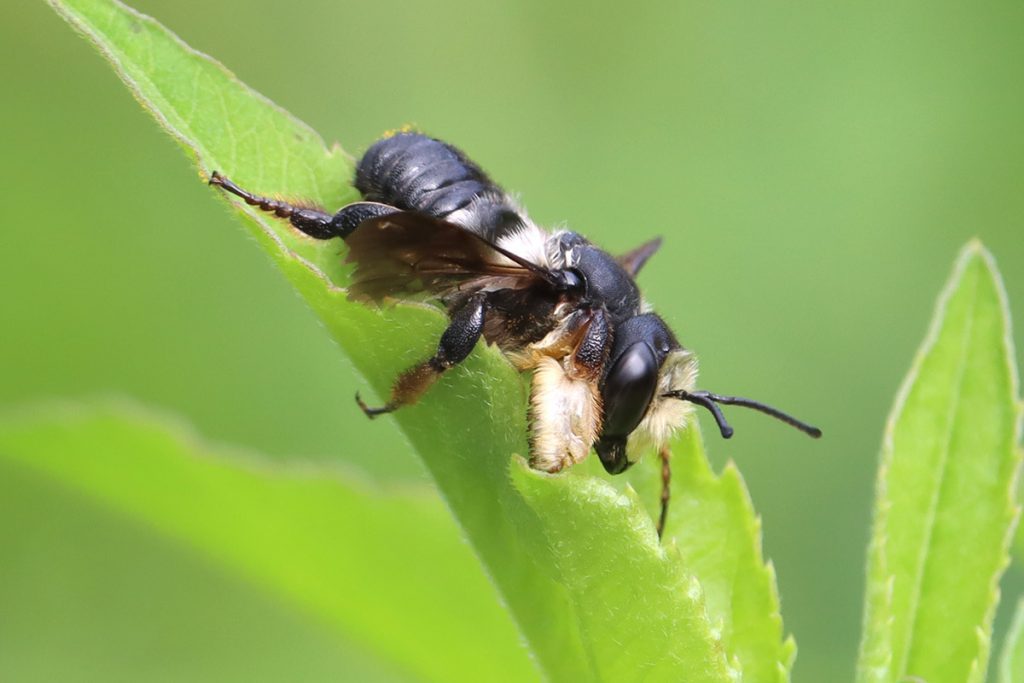
With its smooth abdomen and yellow hair, the male carpenter-mimic leafcutter looks much like a smaller carpenter bee. Note the narrower wing shape and flatter abdomen, and the shape of the head compared to the carpenter. The female mimics the female southern carpenter bee, with an all-black body and less hair than the male.
Carpenter-mimic leafcutter bees on the WFSU Ecology Blog
- We first saw this bee on the Backyard Blog. It was a regular presence in our yard in May and June of 2020. Like a carpenter bee, it was aggressive towards other pollinators in our flower patch, especially wasps.
- In July of 2020, I saw the female when shooting pollinator footage at Elinor Klapp-Phipps Park.
- In 2022, both the male and female were regular visitors to the yard over several months. In the fall, a cuckoo leafcutter hung around when the female was in the yard.
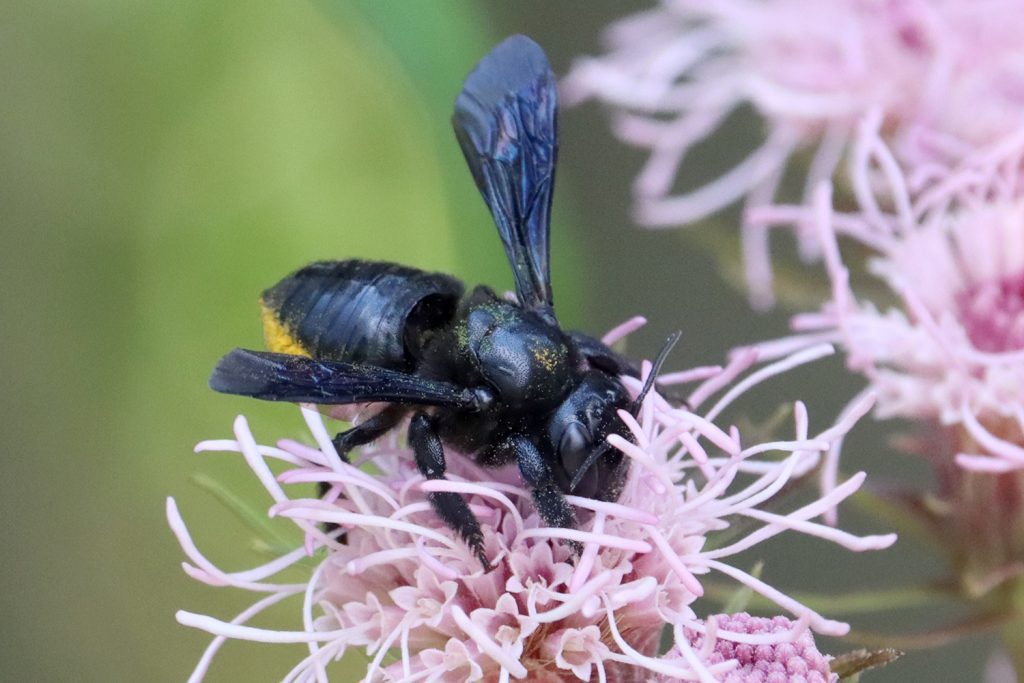
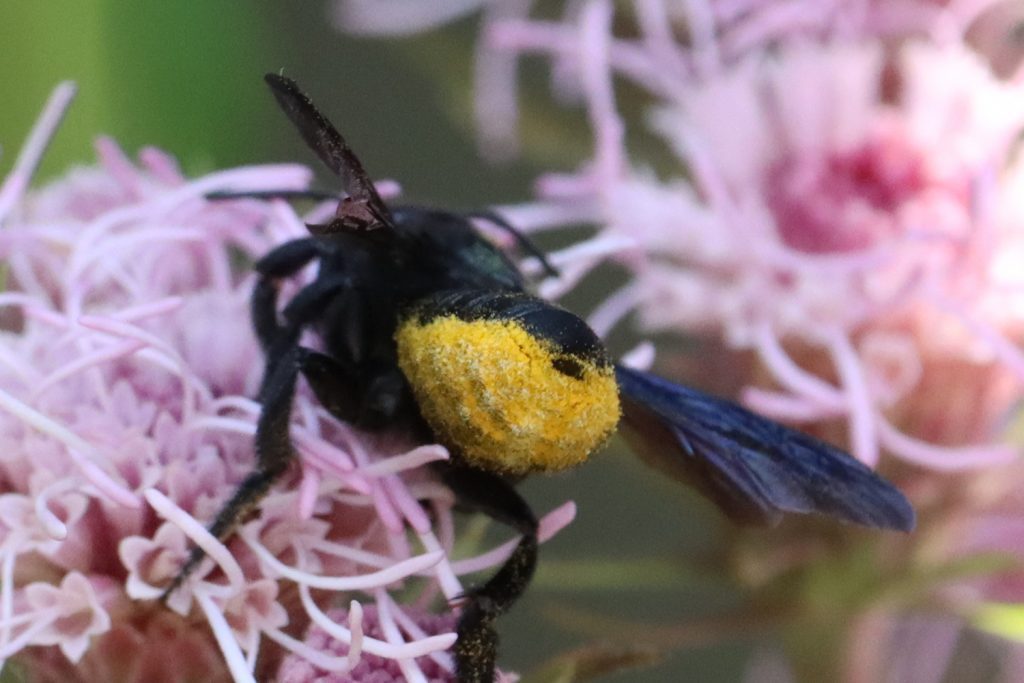
Subgenus Chelostomoides

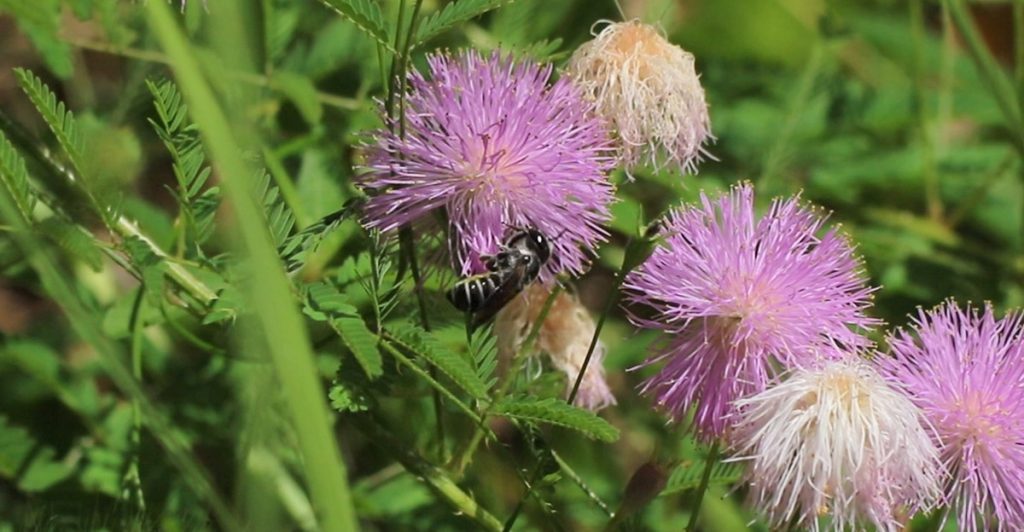
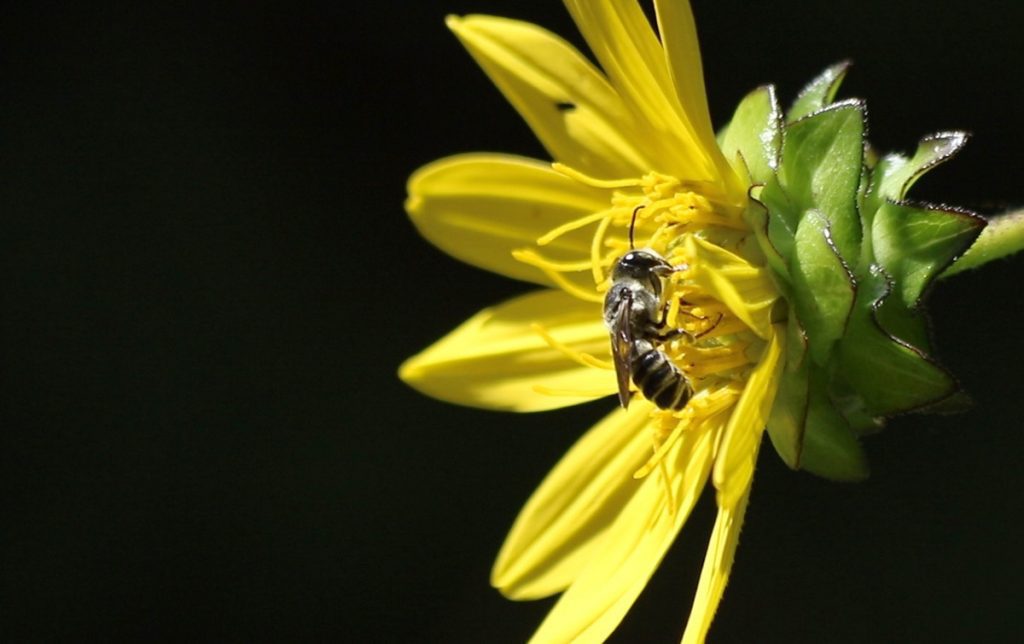
This is another species of leafcutter I spotted while shooting video in Klapp-Phipps Park in Tallahassee. I couldn’t narrow the ID to anything more specific than genus, which isn’t uncommon for bees. This subgenus of Megachile does not make their nests with leaves, but rather with plant resins. So this is considered a mason bee.
A bee in this subgenus briefly visited our yard in May of 2023. iNaturalist identified it as a bellflower resin bee (Megachile campanulae), a bee not otherwise observed in Leon County and sparsely in Florida. No one has confirmed it, and this was the only time I saw it in the yard. If I cross paths with it again, perhaps a few different photos at different angles might help with an ID.
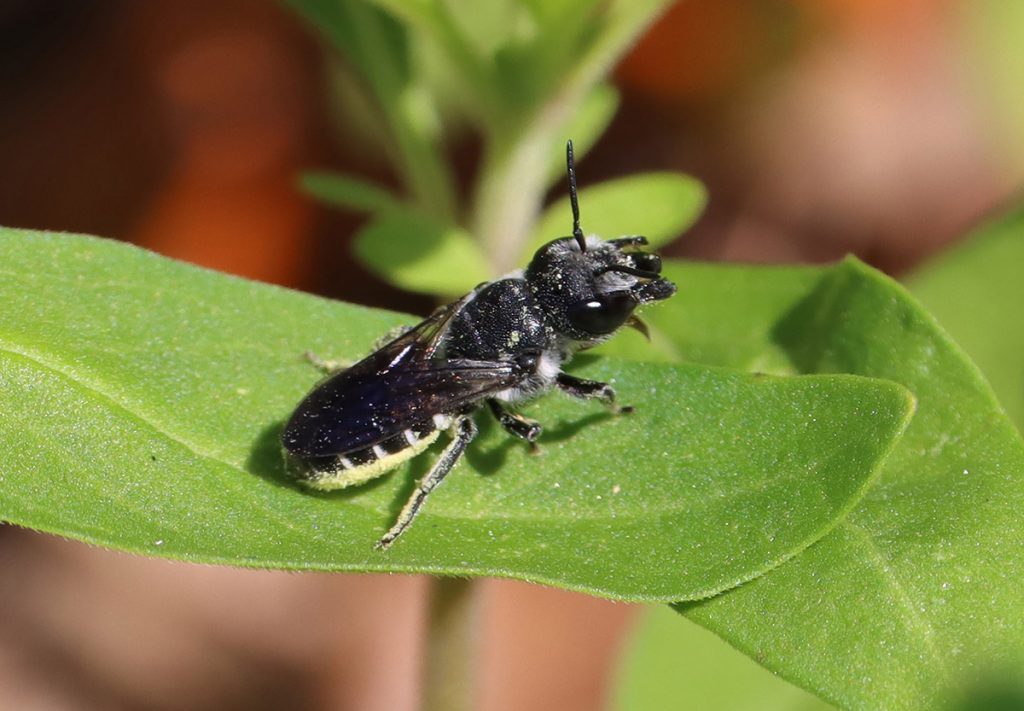
Flat-Tailed and Petulant Leafcutter Bees
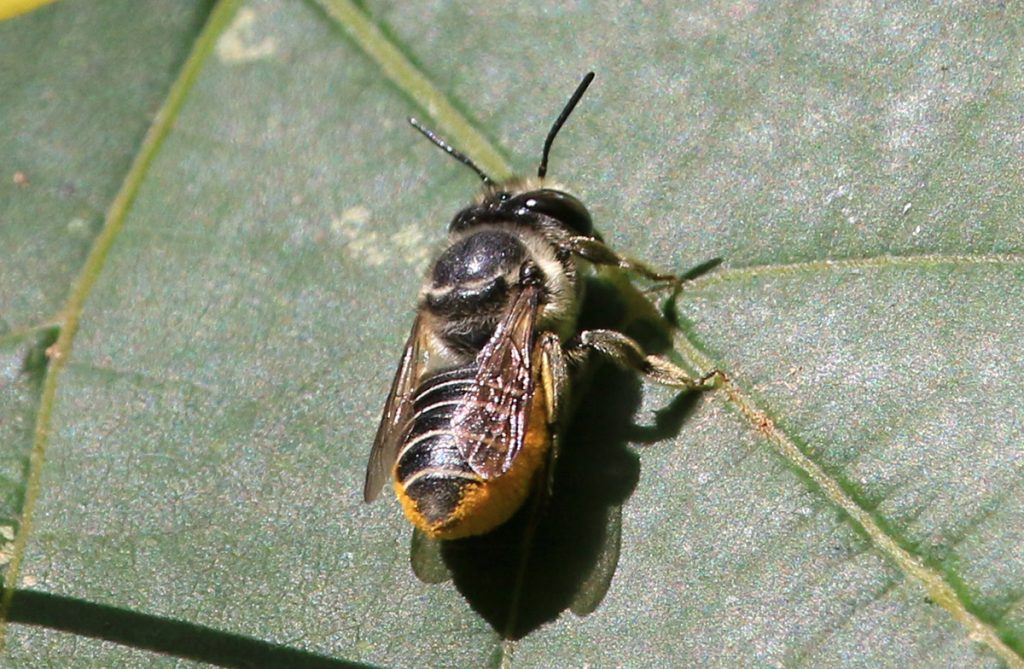
Here are two very similar-looking leafcutters. The images above and below come from two different dates at Klapp-Phipps Park, and I had at first thought they were both flat-tailed leafcutter bees. After loading the images into iNaturalist, it appears they might be two different species. Bee researcher Dr. John Ascher of the National University of Singapore is very active on iNaturalist, and suggested petulant leafcutter for the bee above.
Dr. Ascher confirmed flat-tailed leafcutter (Megachile mendica) for the image below, which was taken in my yard. Looking at images of both bees in Google image searches, and on their Discover Life pages, the differences between flat-tailed and petulant leafcutters seem to be highly technical. Maybe more technical than I’m ready to dive into and learn about for the amount of time I have to write this post; but, like I keep saying, I’ll keep returning to these pages with new photos and any other information I learn.
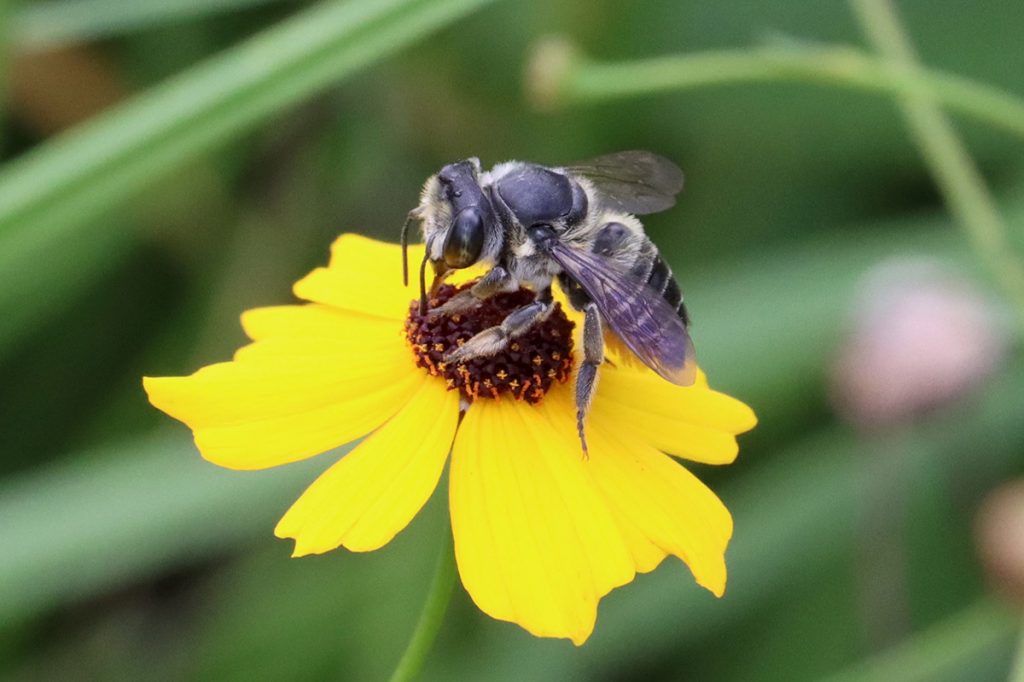
Perplexing rotund-resin bee (Anthidiellum perplexum)
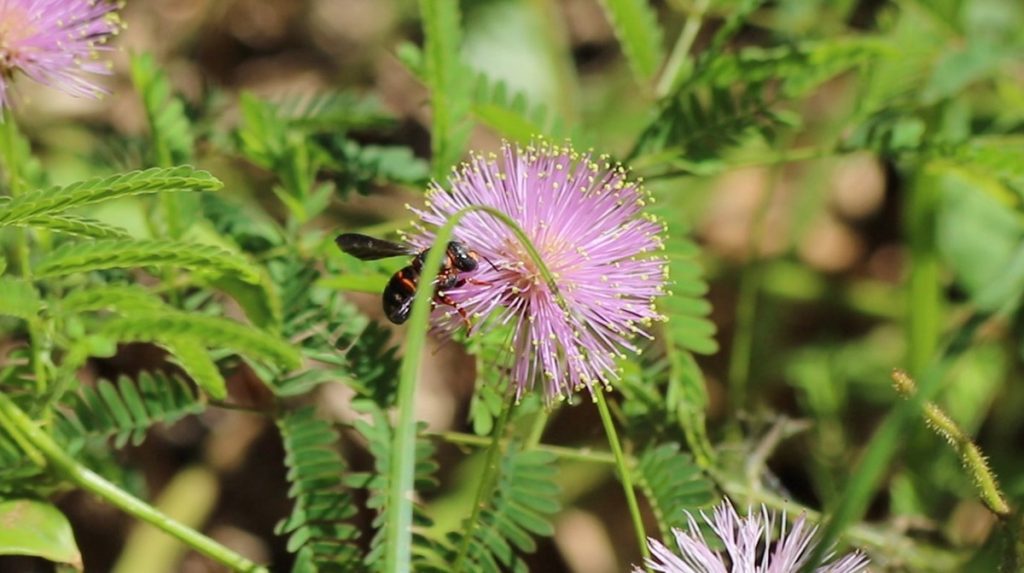
I have only one image of this bee, from a patch of sensitive plants at Klapp-Phipps.
Cuckoo Leafcutter Bees (Genus Coelioxys)
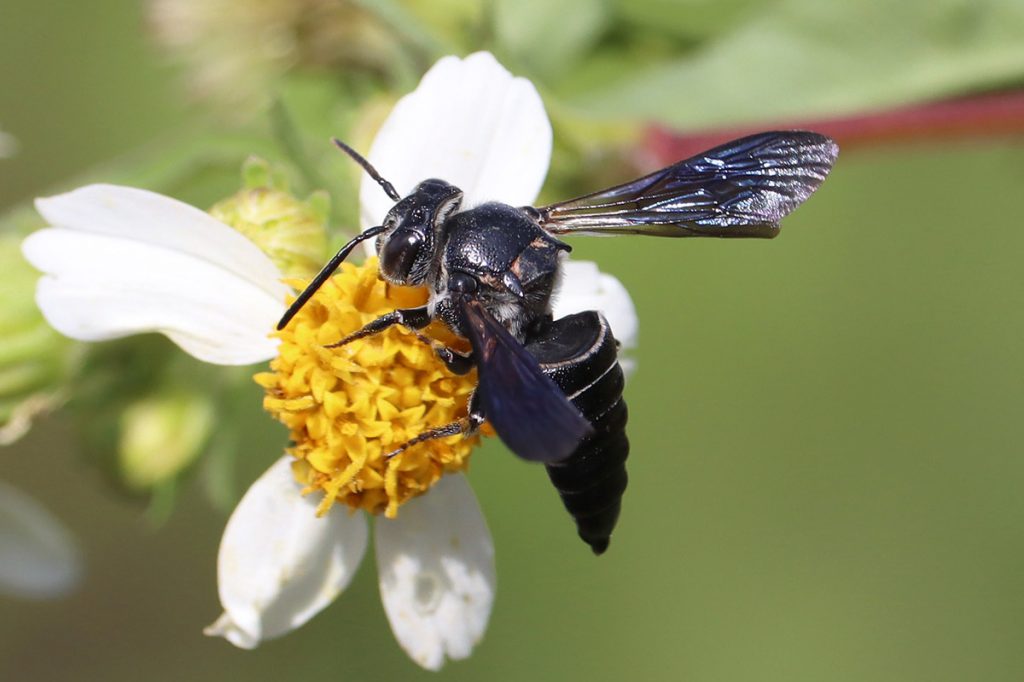
There are different families of cuckoo bees in the Apidae family, listed above. This cuckoo bee is in the Megachilidae family, so it is genetically a leafcutter even if its reproductive habits more closely resemble other, more distantly related cuckoo bees. Like other bees and wasps labeled “cuckoo,” this is a kleptoparasite. Coelioxys lays its eggs with those of other bees, the larvae hatching killing the larvae of the host species (typically other leafcutters), and eating the pollen left by their mother for them.
The Coelioxys dolichos in the photo above is from my garden in October of 2022. It was a species new to my yard, after a year in which I saw more leafcutter bees than ever before.
Because cuckoo bees don’t keep nests of their own, they lack the ability to carry pollen on their legs or abdomens.
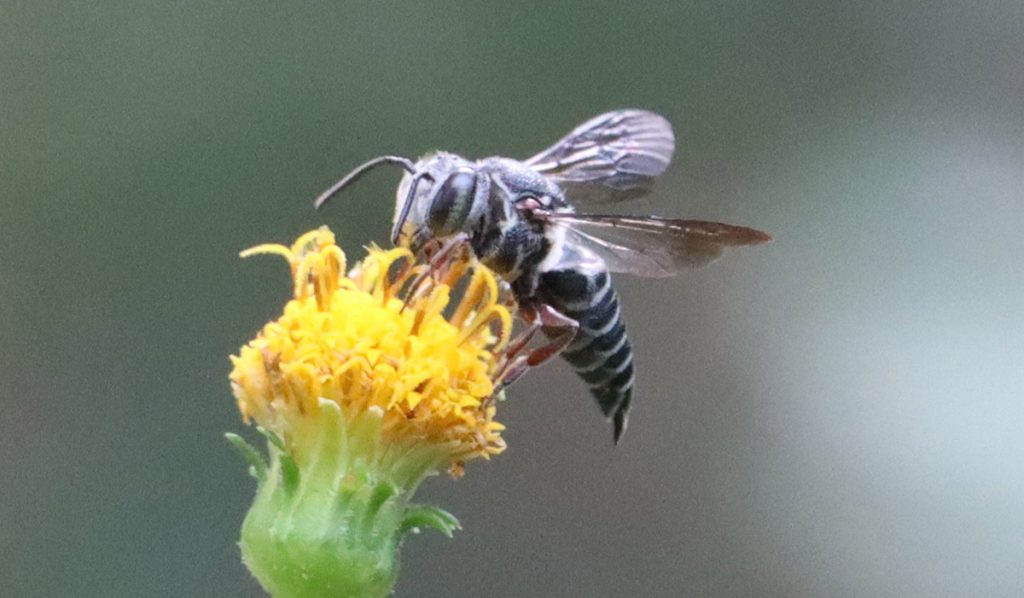

Halictidae
Sweat bees
Sweat Bees
This is a large and diverse family of bees. Sweat bees are some of the smaller bees we see on our flowers, from the gnat-sized Dialictus bees to the somewhat larger and more colorful Augochlorini. They are said to be attracted to human sweat.
Lasioglossum, subgenus Dialictus
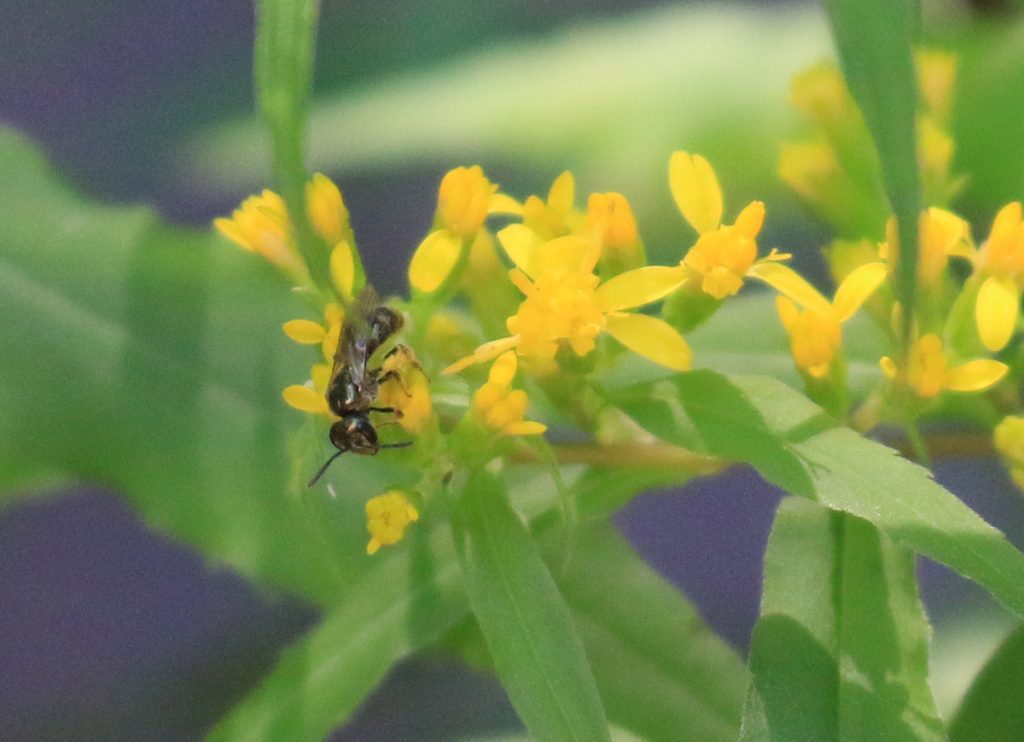
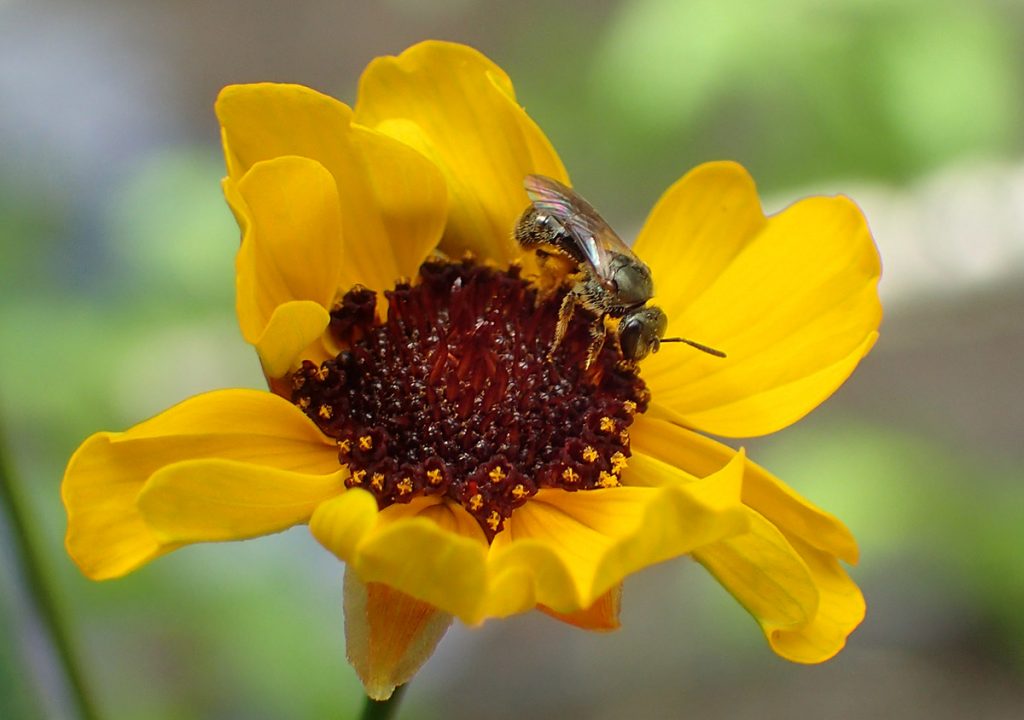
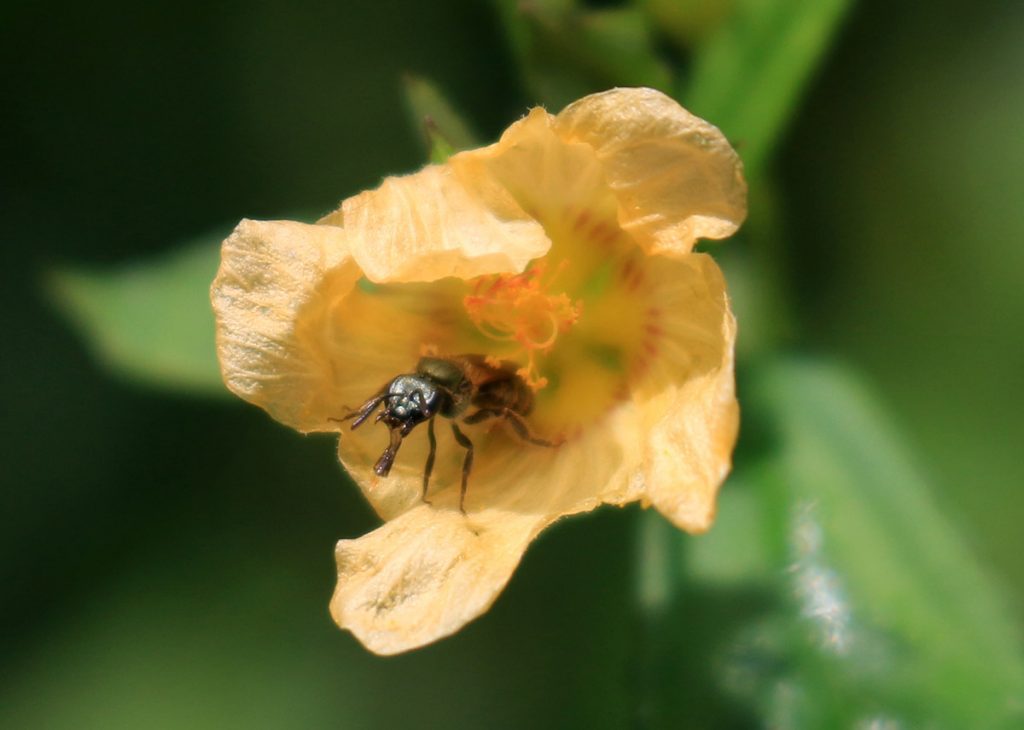
Dialictus is a subgenus of the Lasioglossum genus, and it has hundreds of very similar-looking bees. They are difficult to differentiate, even with a microscope. I see quite a few in my yard, and some are slightly larger than others. I figure, based on size, that I have at least two species. Or maybe it’s one species with larger males or females?
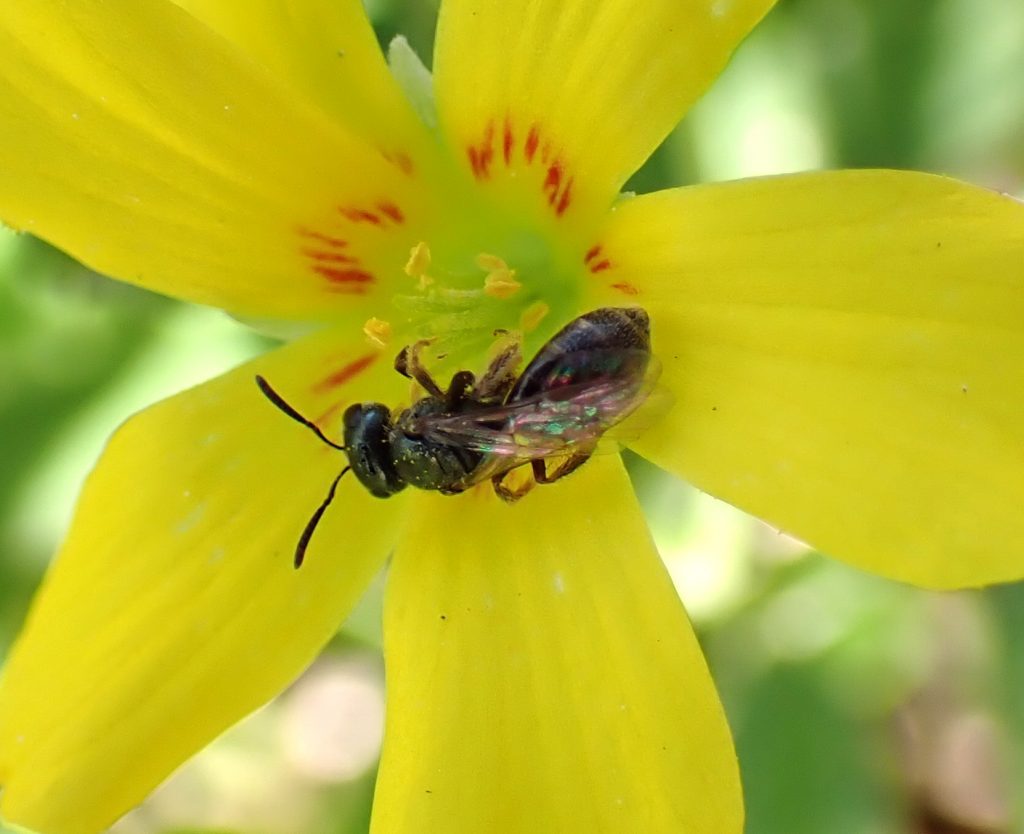
Lasioglossum reticulatum
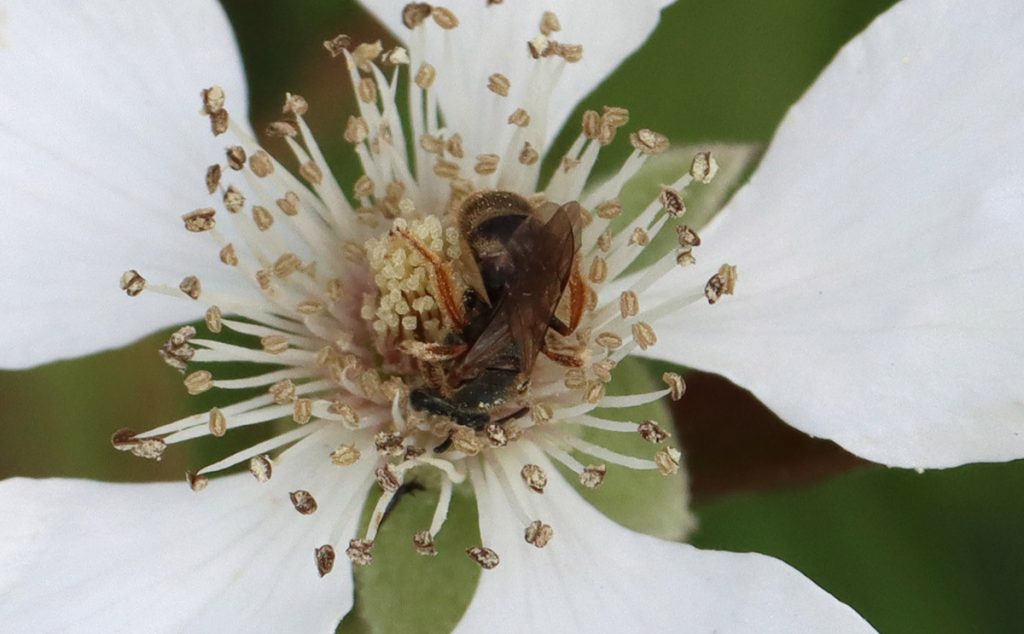
Here’s a Lasioglossum, subgenus Dialictus, bee for which I actually received a species-level identification. It looked not quite like a Poey’s furrow bee, and not quite like other Dialictus. This is a southeastern bee, which, according to its bugguide page, flies from March to November in most of its range, and year-round in Florida.
Lasioglossum floridanum
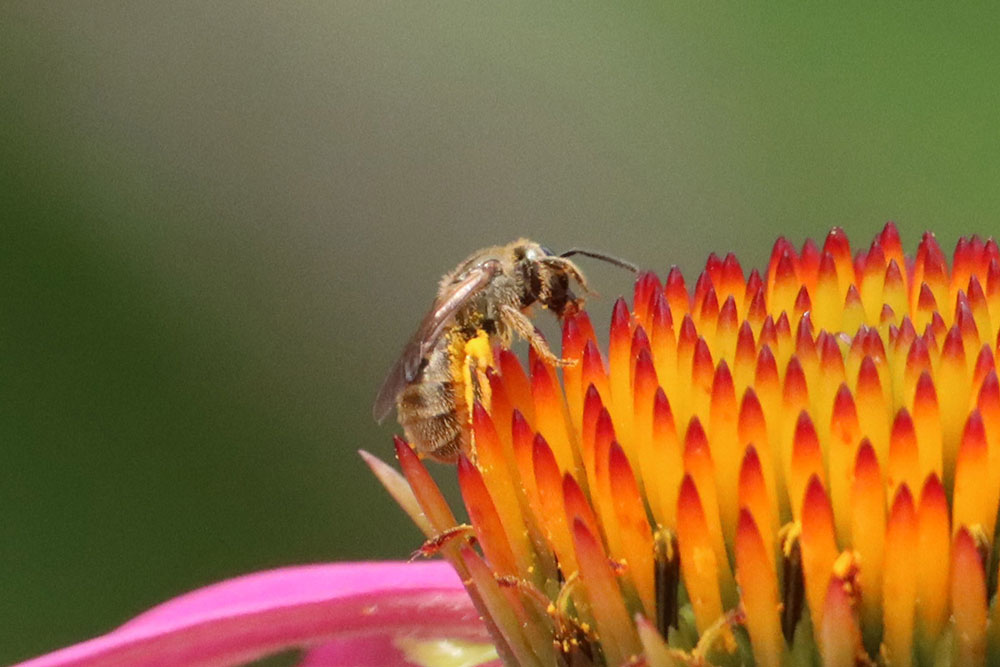
In 2023, I made an effort to photograph as many small bees in our yard as possible. Here is a second species-level identification for a Dialictus sweat bee.
Poey’s Furrow Bee (Halictus Poeyi)
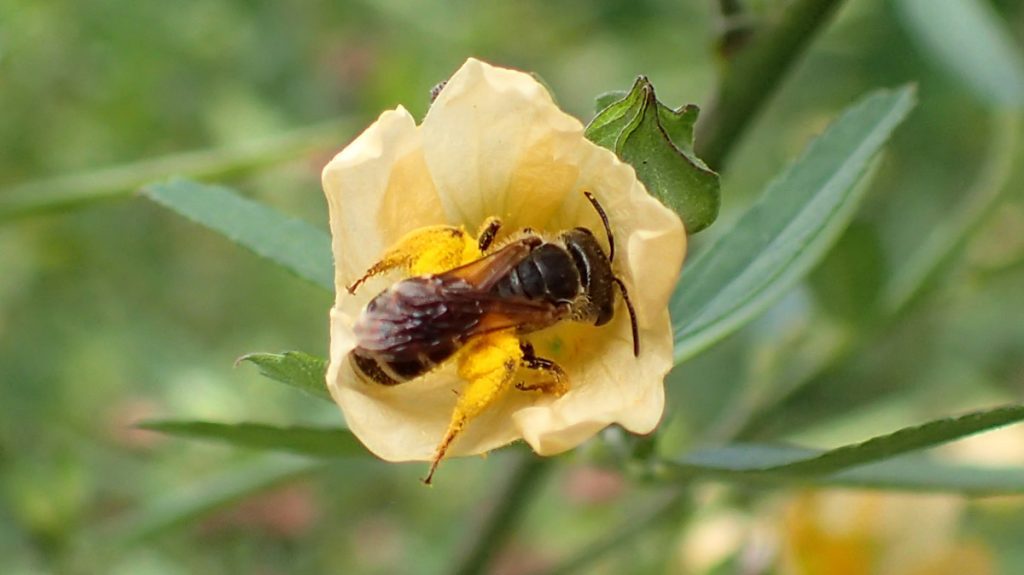
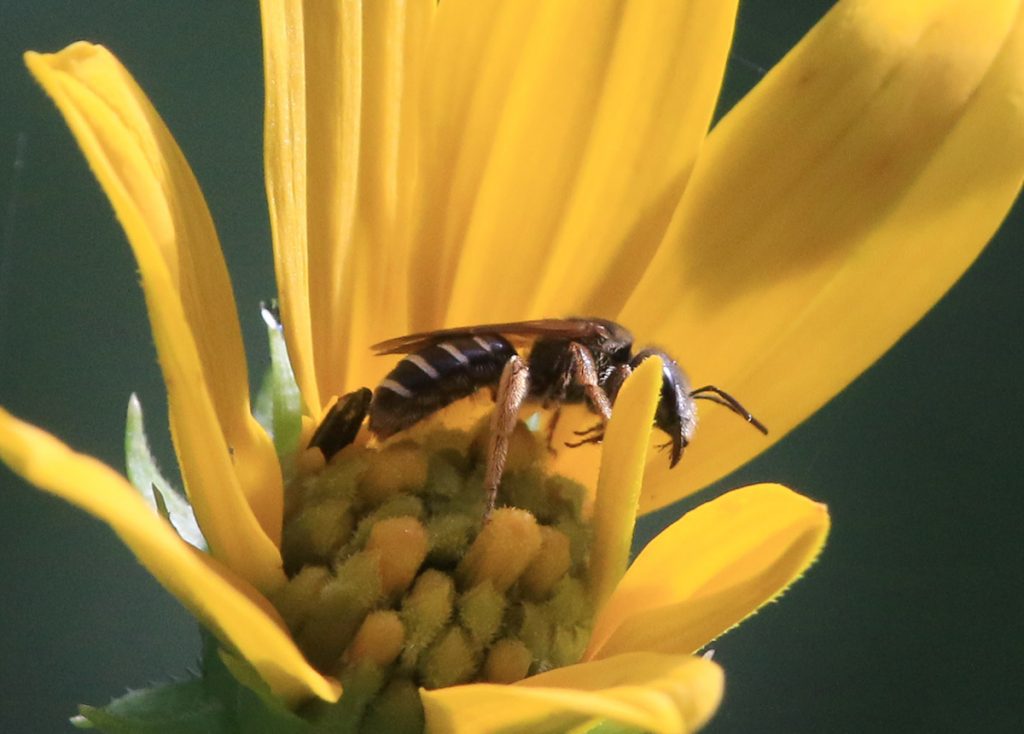
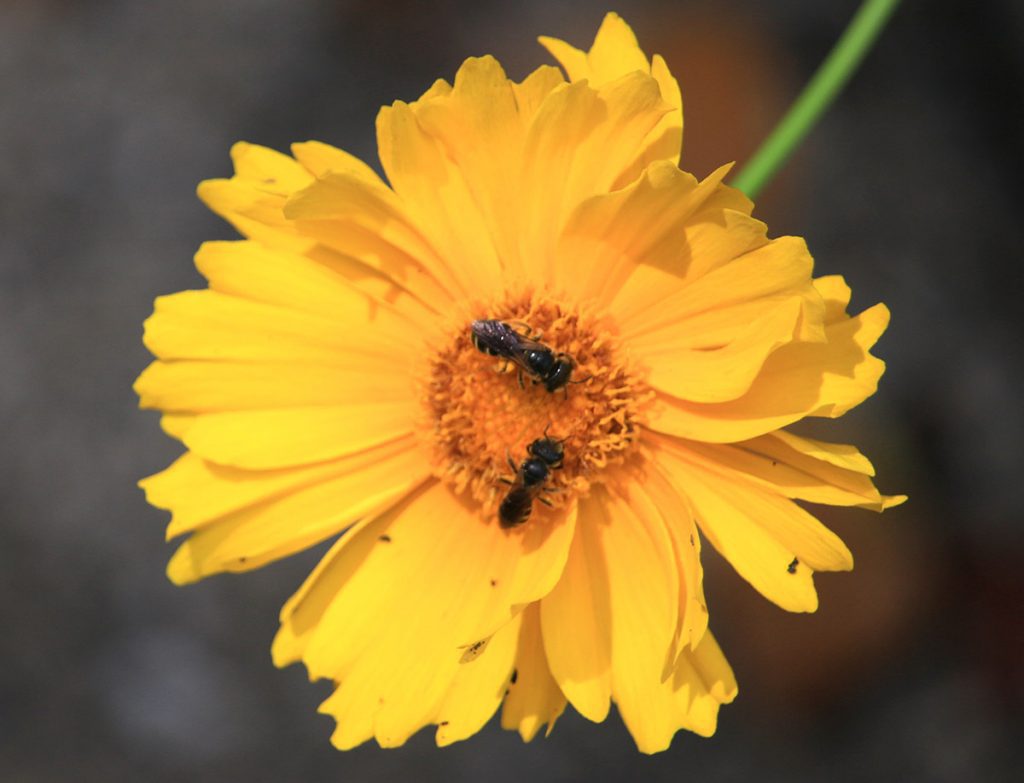
Poey’s furrow bees are just a little larger than the largest Dialictus in our yard, and they often use the same flowers. The furrow bees have a more pronounced yellow and black striping on the abdomens, and big, thick heads. These small bees are common in north Florida yards and parks.
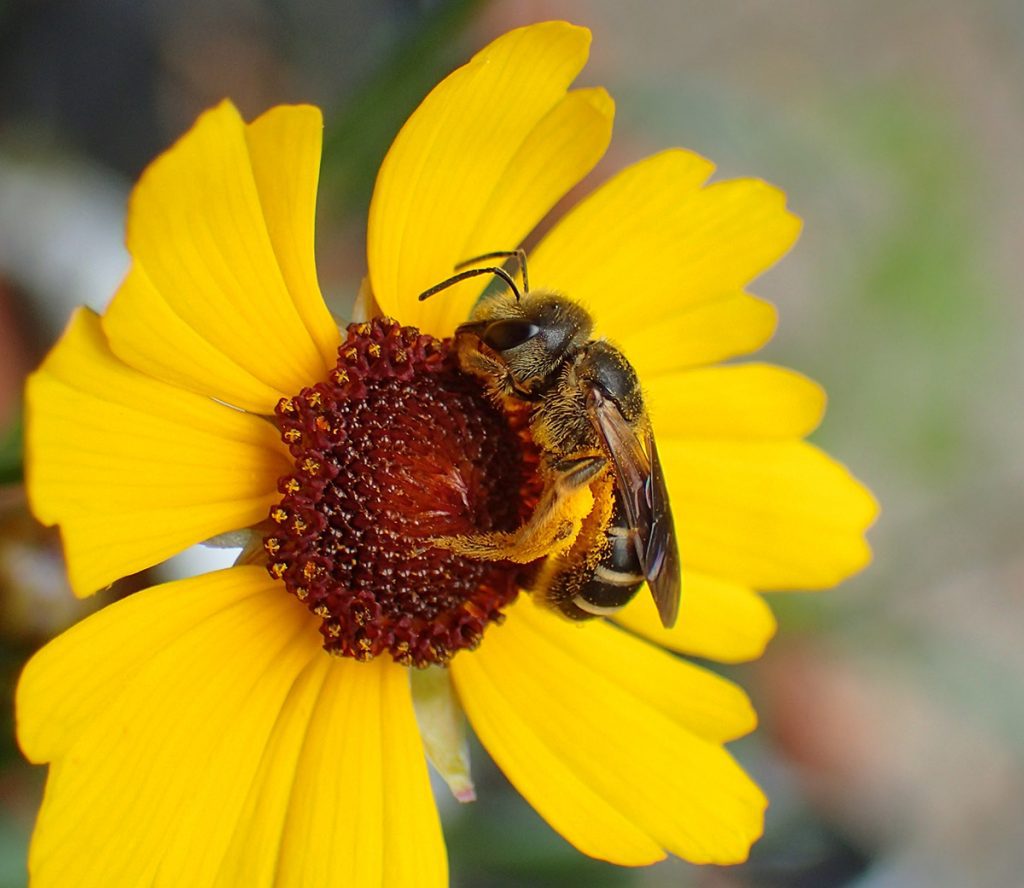
Above is the female Poey’s furrow bee. In 2022, I saw a male for the first time when one attempted to mate with a female.
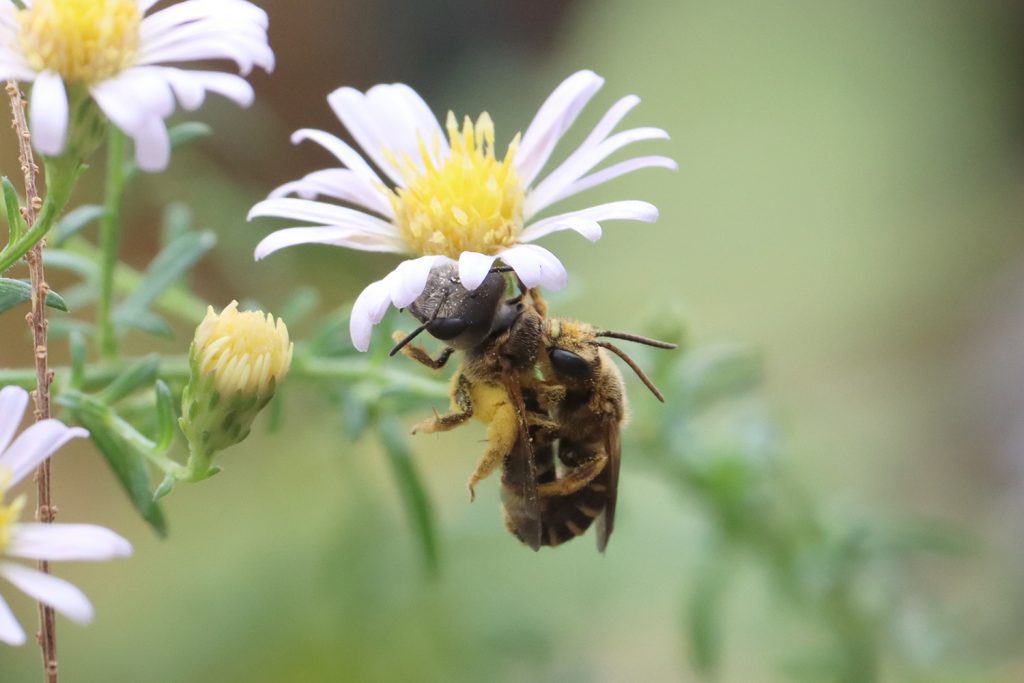
You can see the female, left, has a larger and less hair-covered head. Also, as in most bee species, the female collects pollen to bring to a nest, whereas a male has no means to collect pollen. This photo was taken in the fall when furrow bees stop flying and females find a place to lay low during the cold months. Before doing so, they mate, and the female carries the next year’s brood within her. In the spring, she’ll emerge and make a nest.
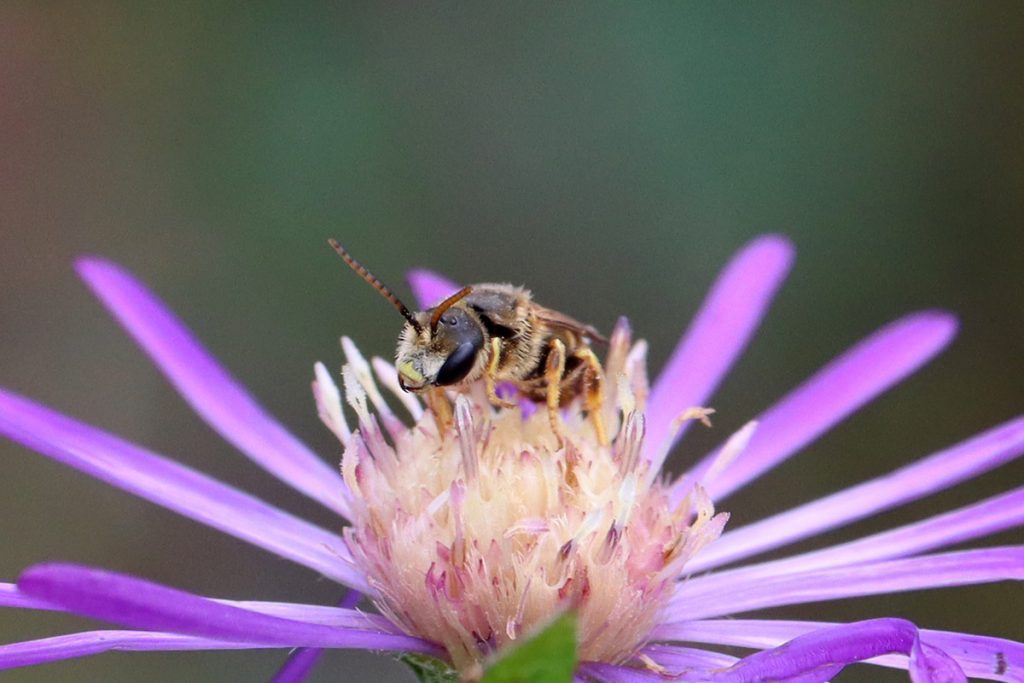
Augochlorini tribe
There are two or three species we’re likely to see in our area, and these are very similar looking. Augochlorine bees are solitary nesters.
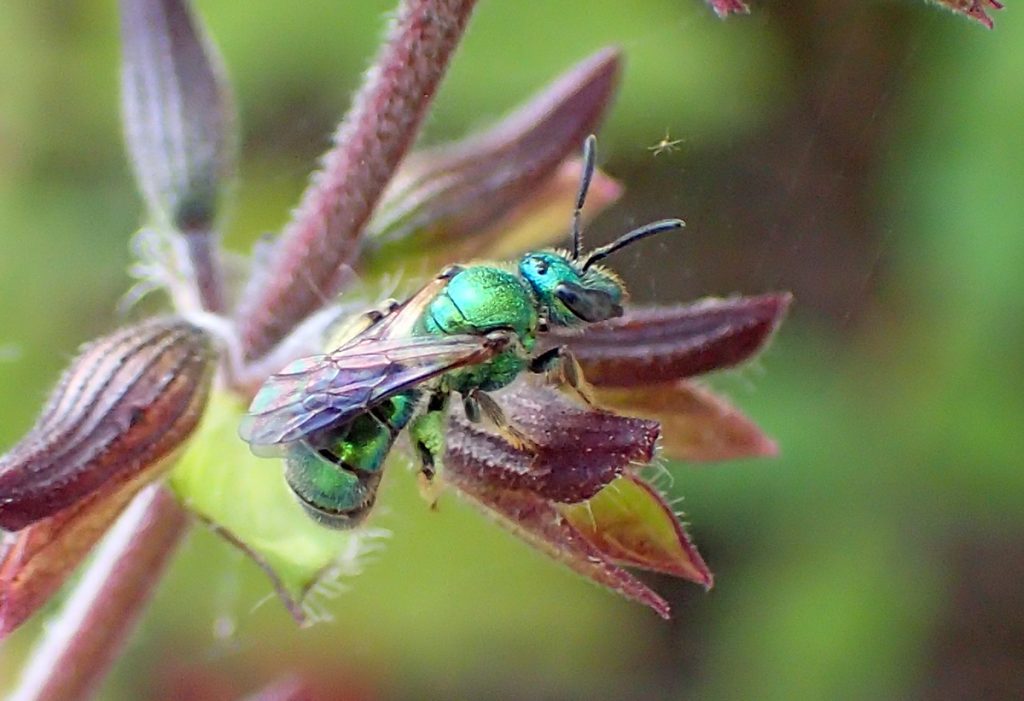
The photo above was submitted to iNaturalist and confirmed to be a pure green sweat bee (Augochlora pura). Another possibility in our area is the metallic-epauletted sweat bee (Augochloropsis metallica).
Below are a few photos of Augochlorine sweat bees. I’m noticing that very few get species-level confirmations on iNaturalist. One of the bees below has a deep blue color, but that’s a normal color variation for these bees. They also resemble the female brown-winged striped-sweat bee (which we’ll see next), but those have a few features that make them easier to identify.
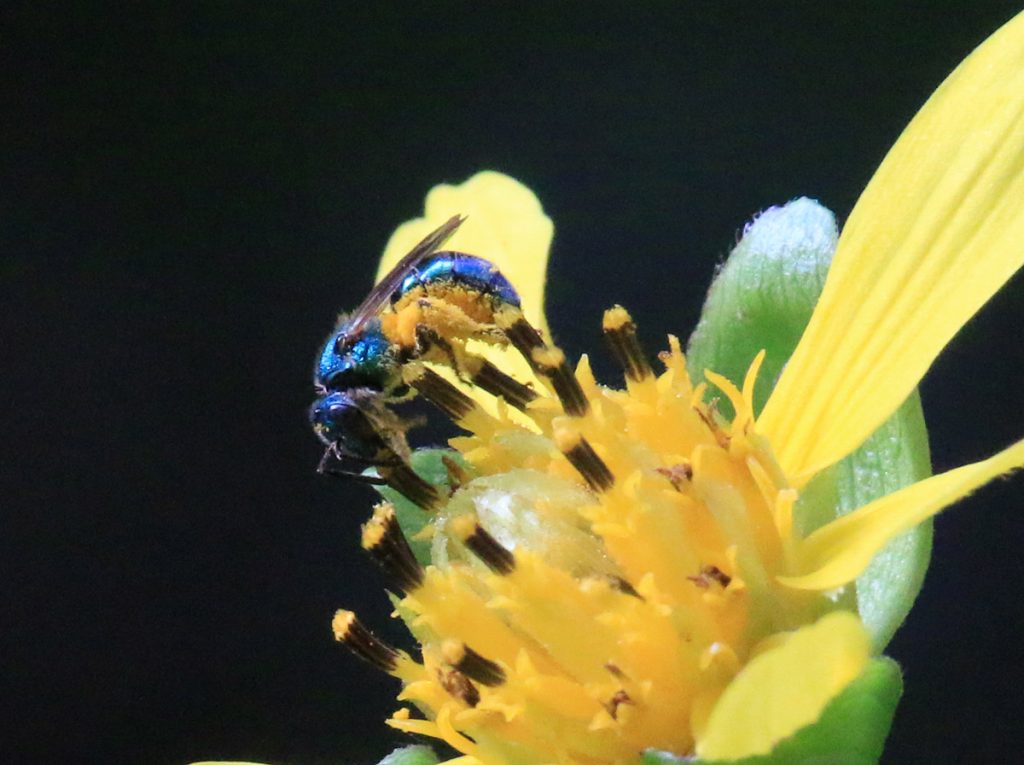
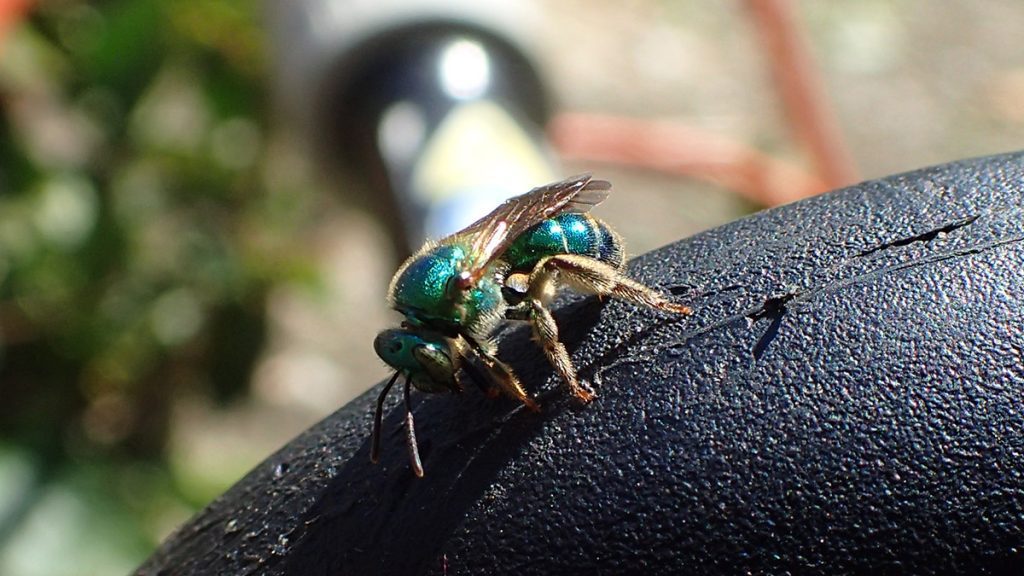
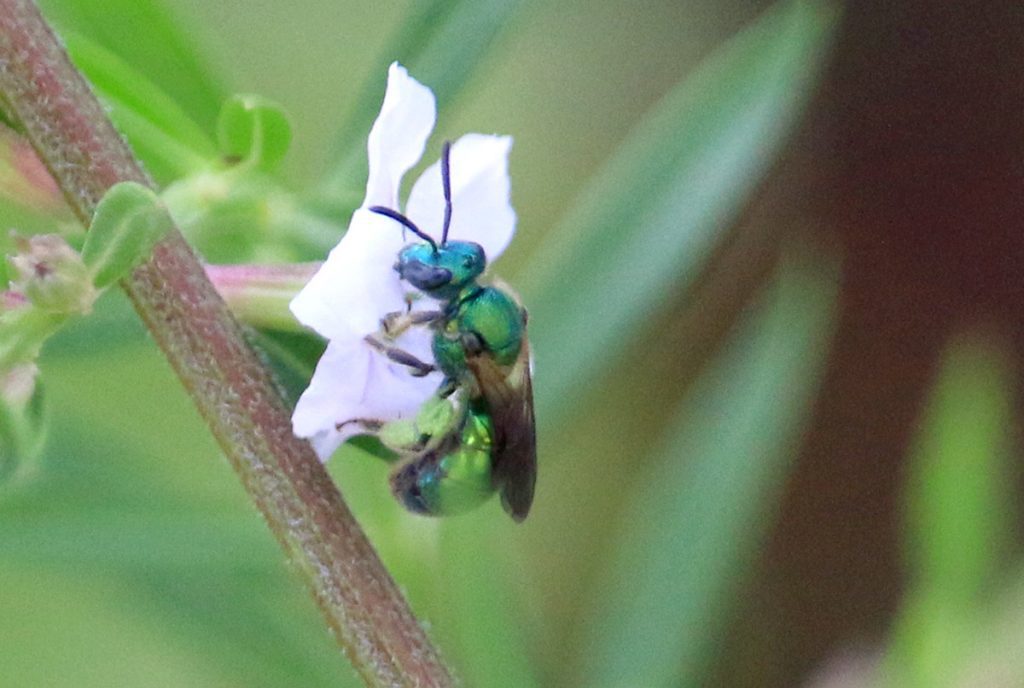
Brown-winged striped sweat bee (Agapostemon splendens)
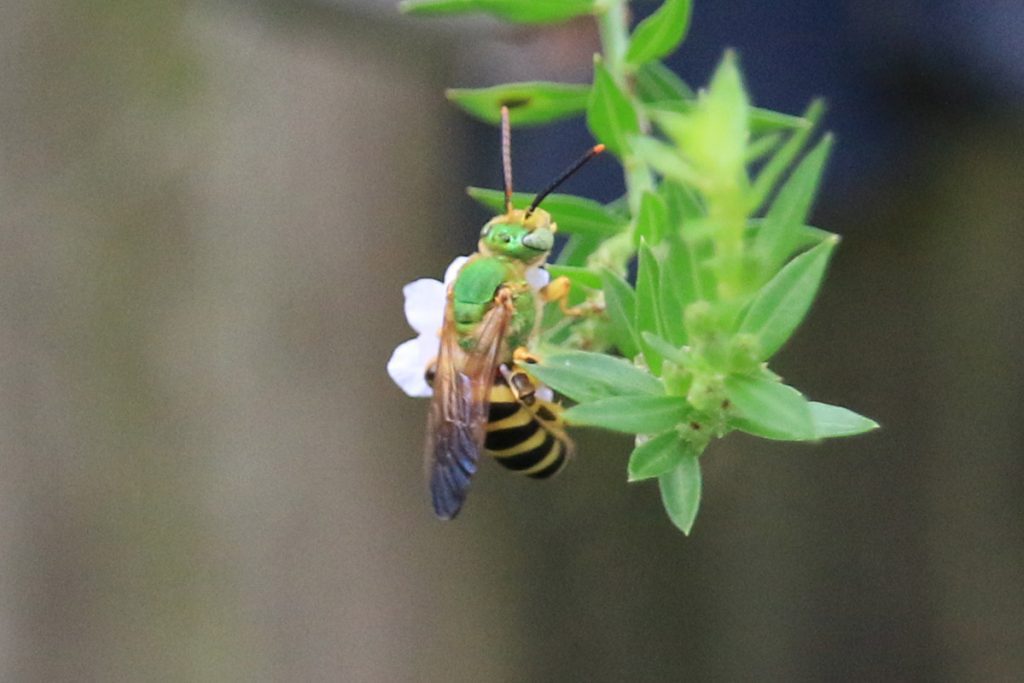
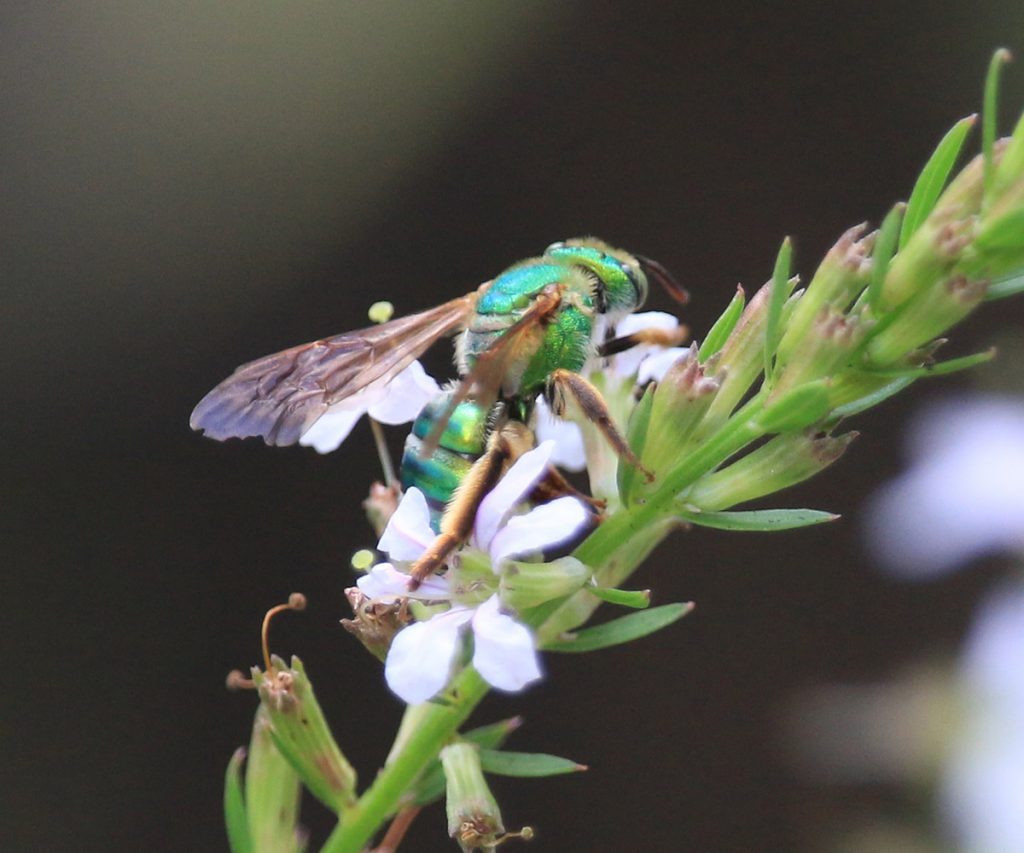
The male brown-winged striped sweat bee is unmistakable. In August 2019 and 2020, I saw larger and larger numbers of the males on flower patches in our yard. I saw females, which have a similar green coloring to the Augochlorine bees, as early as June 2020. In years since, the start of the population explosion varies by a couple of weeks, usually coinciding with the late summer blooming of dotted horsemint.
One subtle difference between Agapostemon and Augochlorine bees is the wings. Female brown-winged striped sweat bees have murkier wings than Augochlorine bees. If you scroll up to the photo of the pure green sweat bee, its wings look more like they’re made of glass panes. Another difference is that the female brown-winged striped sweat bee has more pronounced stripes on its abdomen:
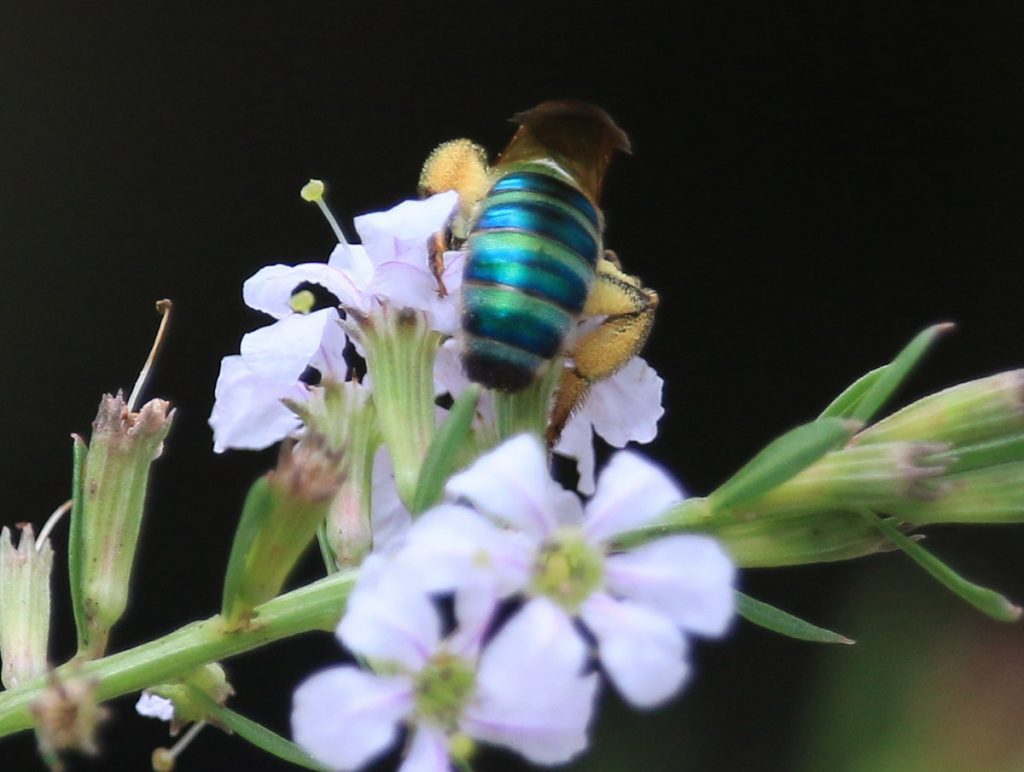
Sweat bees are ground nesters, though they may also nest in rotting wood. In July of 2019, I removed an old wooden bench from the yard, and a green sweat bee flew out. I followed it as it appeared to search the ground for a new nesting area. If you have space for a brush pile in your yard, for a place to put a nice-sized fallen branch to let sit and rot, this is one of a few different insects that would make use of that habitat.
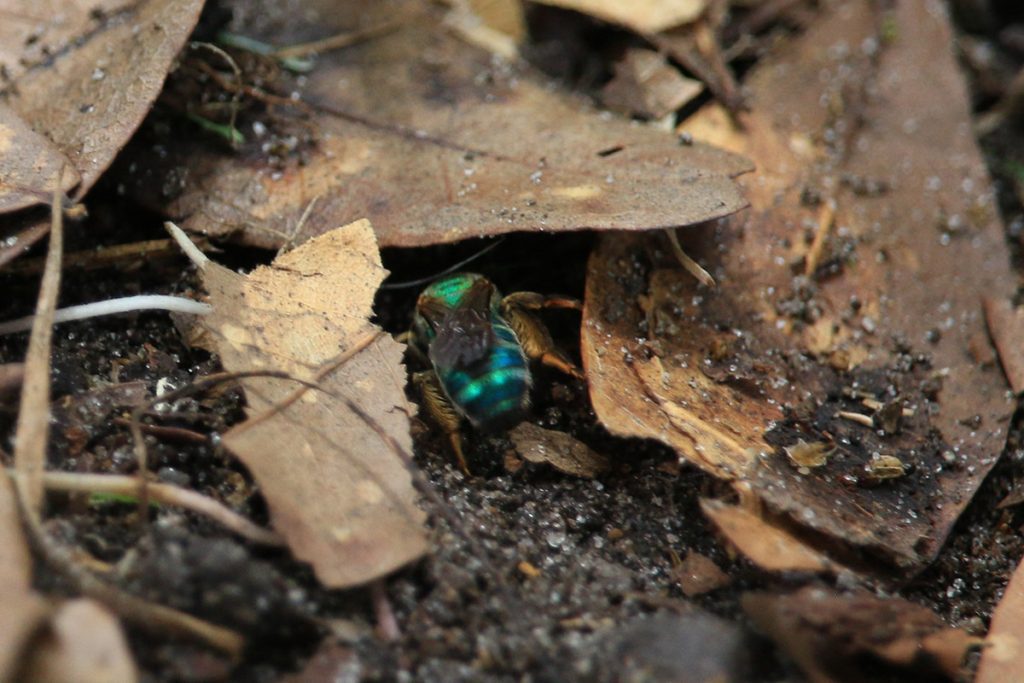

Andrenidae
Mining bees
Andrena genus
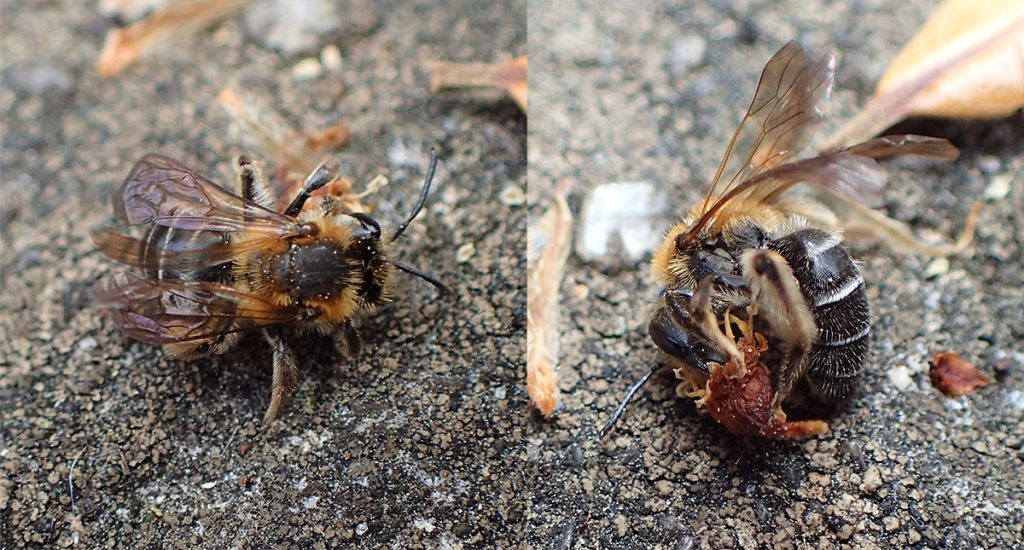
Mining bees are early flying bees, feeding on nectar from flowering trees such as Carolina cherry laurels, which bloom in the late winter/ early spring.
I saw this bee one time in my yard, tackling some shriveled flowers on the pavement. Dr. Ascher suggested the subgenus Archiandrena in iNaturalist.
In April of 2021, I saw a couple of mining bees returning to or digging new nests under individual leaves scattered on open soil. Although mining bees often nest close together, sometimes in the hundreds, they are solitary nesters. They do not form hives together; social, hive-building bees and wasps are generally more aggressive than solitary nesters.
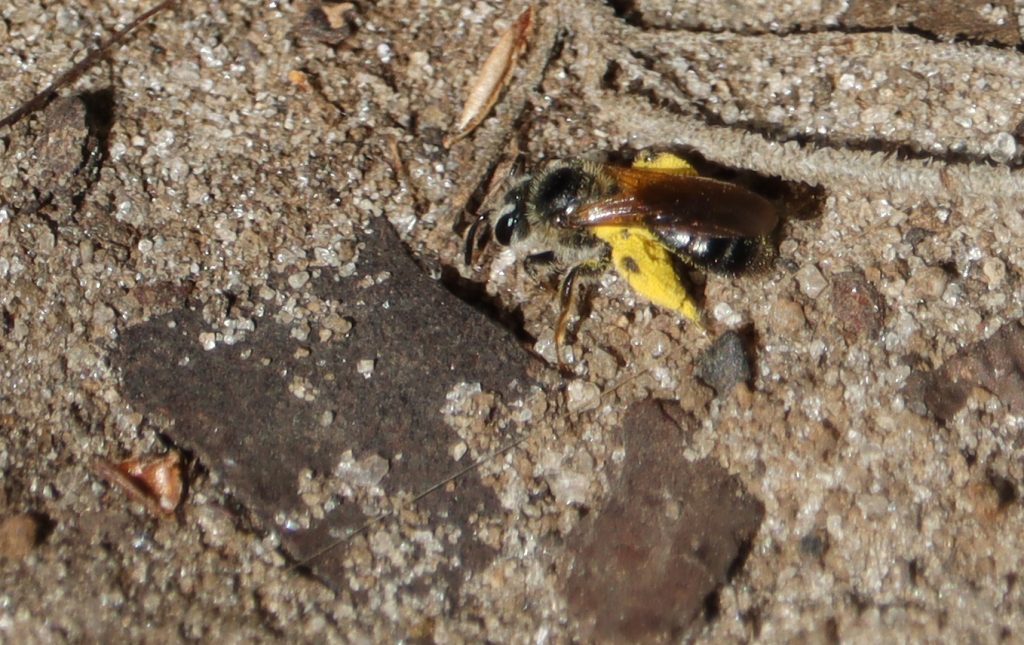
Barbara’s mining bee (Andrena barbara)
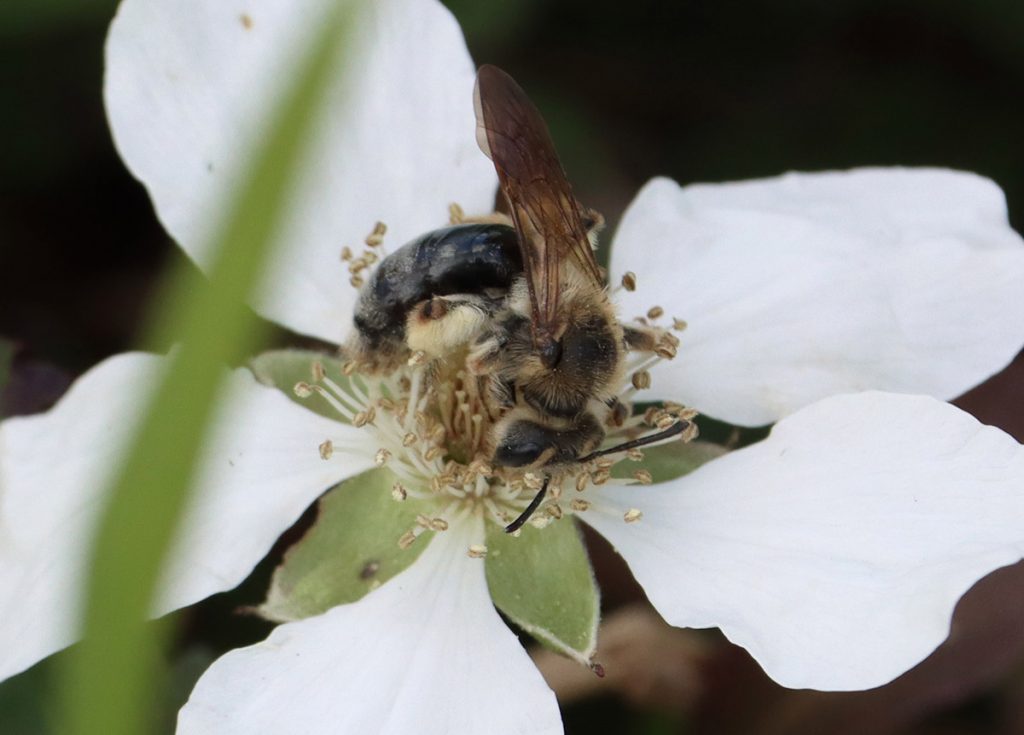
Here’s a bee I first spotted in March of 2023. I’d been watching honeybees visit dewberry flowers, when I noticed a couple of darker bees. They looked like mining bees, but in our yard, I’d only seen those on tree flowers. This is a Barbara’s mining bee.
It has brighter, yellowish hair compared to other Andrena, but I’ll keep an eye out for further iNaturalist suggestions for this bee. According to its bugguide page, it is often overlooked and misidentified.
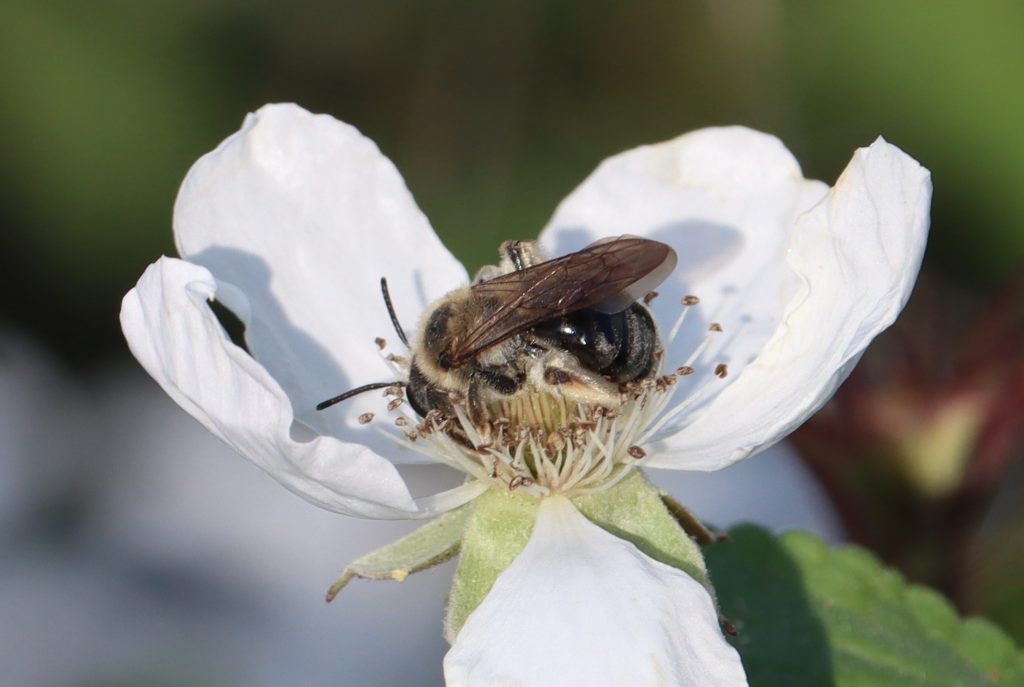
Fairy and Goblin Bees
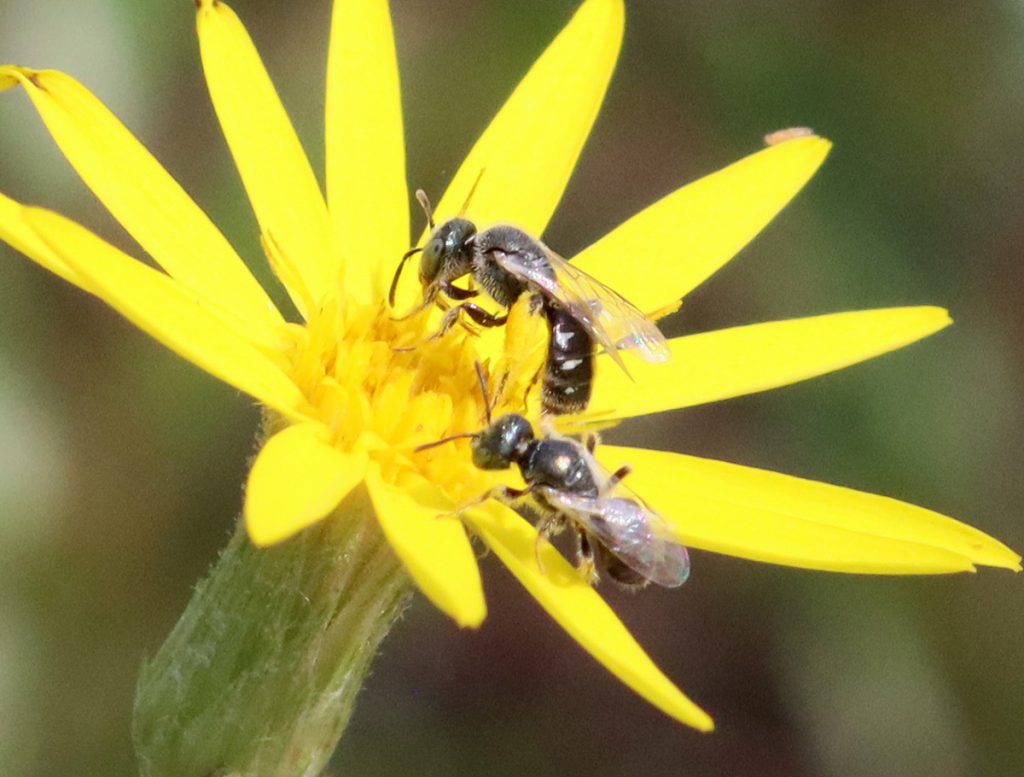
In the mining bee family, there is a subfamily of small mining bees, within which there is a subtribe called Perditina– fairy and goblin bees. The bees in the image above, which I had thought were small Lasioglossum sweat bees, are fairy bees in the Perdita genus.
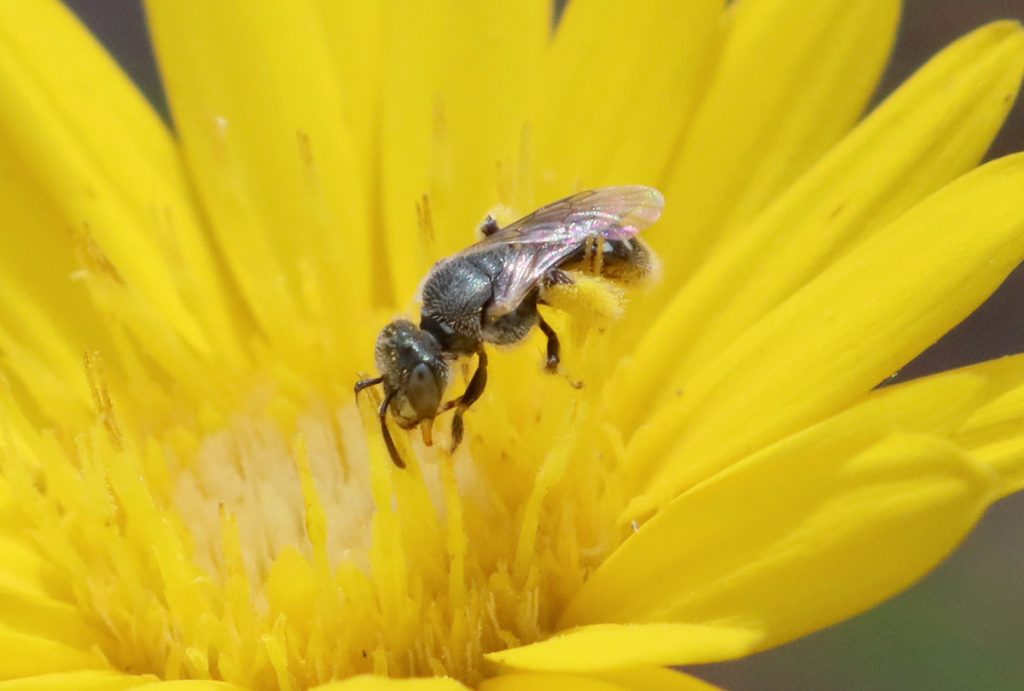
Cousinly fairy bee (Perdita consobrina)
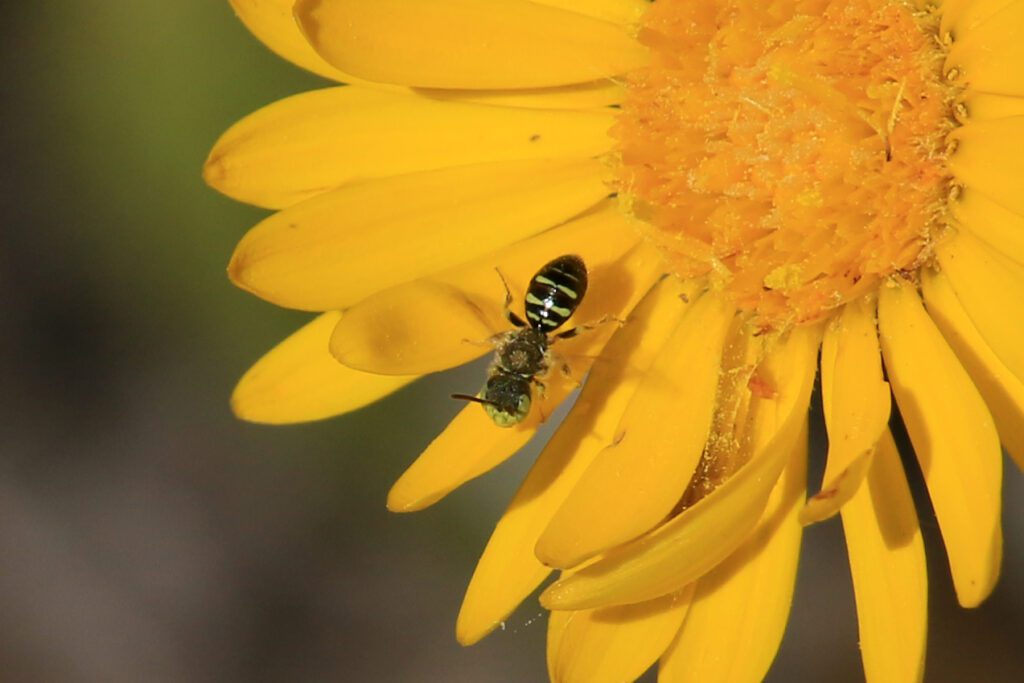
Like the small Lasioglossum sweat bees, fairy bees are small and can be difficult to distinguish from one another. Contrast this bee the fairy bees directly above it on this page. It has a few colorful features – stripes, and a green mouth. Also, note the lack of pollen sacks. This is a male.
I photographed this bee in the Munson Sandhills and uploaded it to iNaturalist, where the site’s top bee curator, Dr. John Ascher identified it. It’s one of only two observations of this tiny bee, and when I went to read more, I found little information about it. This, to me, is the joy of photographing insects and using iNaturalist. The sheer number of insects in the world makes it so that many of them are little understood. This includes insects you may see in your yard. When you take the time to see them, capture an image, and share that image on a platform where researchers can see it and know where you found it, you are providing valuable visual data that can further our understanding of the insect and the habitat it inhabits.

Colletidae
Plasterer- aka polyester- bees
Cellophane Bees (Colletes genus)
Long-faced cellophane bee (Colletes longifacies)
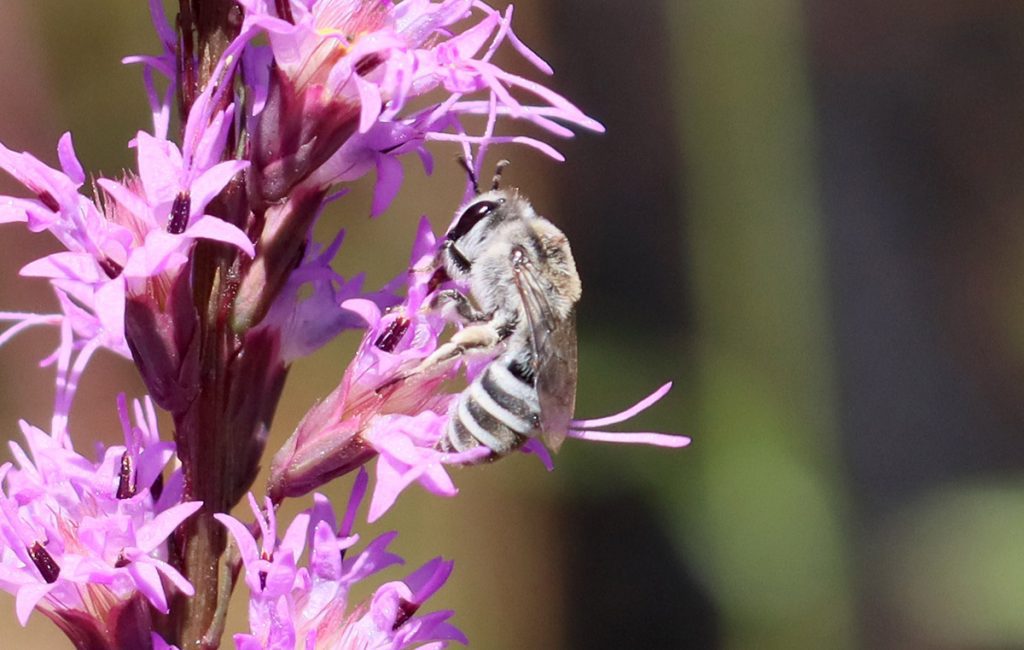
Plasterer bees are solitary ground nesters that line their nests with a secretion that resembles cellophane. The substance is a natural polyester, and so plasterer bees are also called polyester bees.
Cellophane bees are a genus of bees (Colletes) in the plasterer bee family (Colletidae). The image above hasn’t yet gotten a species-level identification in iNaturalist. One likely option is sandhills cellophane bee, as I spotted this one in a sandhill habitat, and the species is one of a couple of Colletes species observed in the Florida panhandle.
Edit 10-28-21: It looks like this is a long-faced cellophane bee (Colletes longifacies), based on an identification by bee researcher Dr. John Ascher. This central/ north Florida endemic, he says, is “Historically overlooked due to late flight season.” As Dr. Ascher notes, Colletes longifacies is a “rarely recorded, localized, and specialized species.” It has previously been recorded on clusterleaf blazingstar, a fall-blooming wildflower.
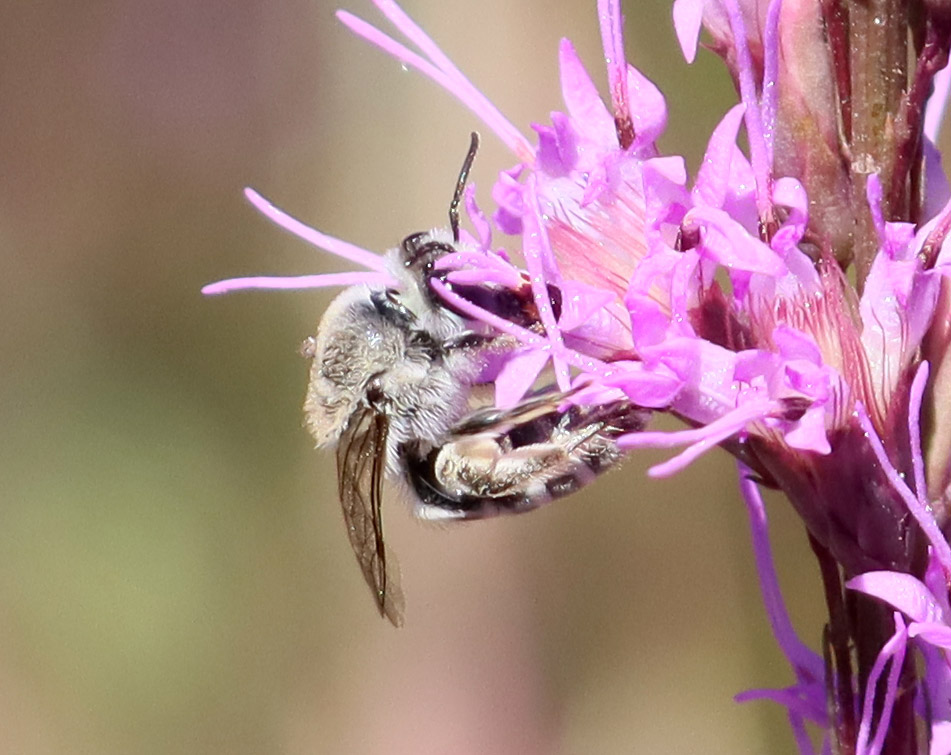
Rufous-backed cellophane bee (Colletes thoracicus)
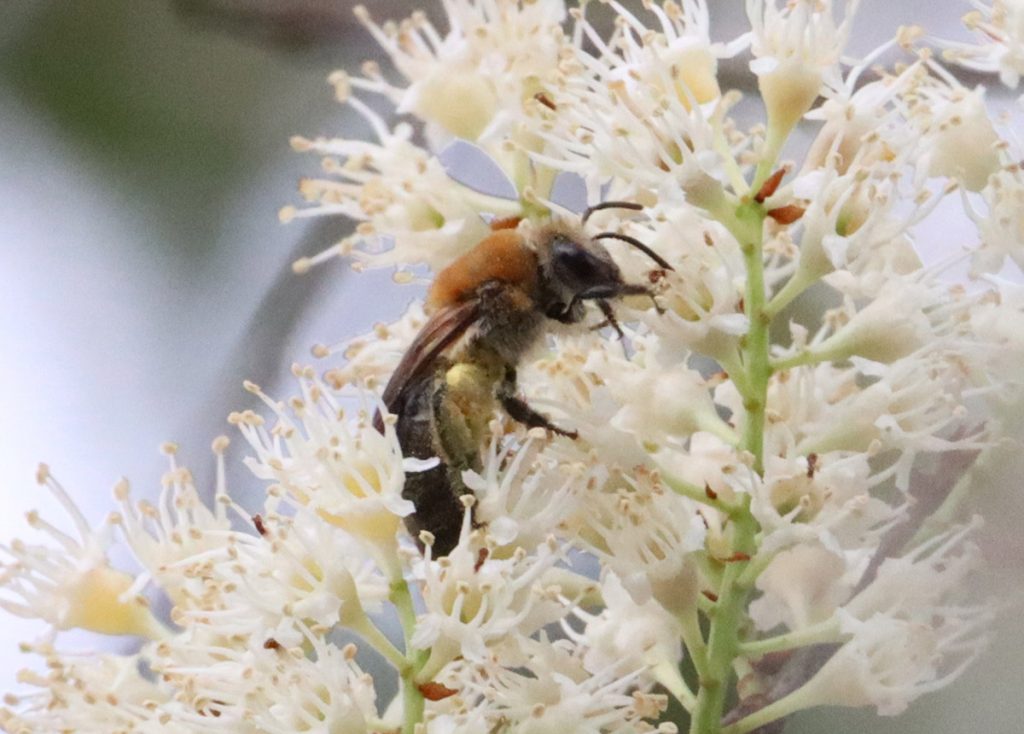
I saw this bee on March 1, 2023, on a cherry laurel tree overhanging our yard. According to bugguide.net, this bee flies in January and February in Florida. Based on this observation, though, I’d say that as close to Georgia as Tallahassee is, that here the bee flies a little bit into March.
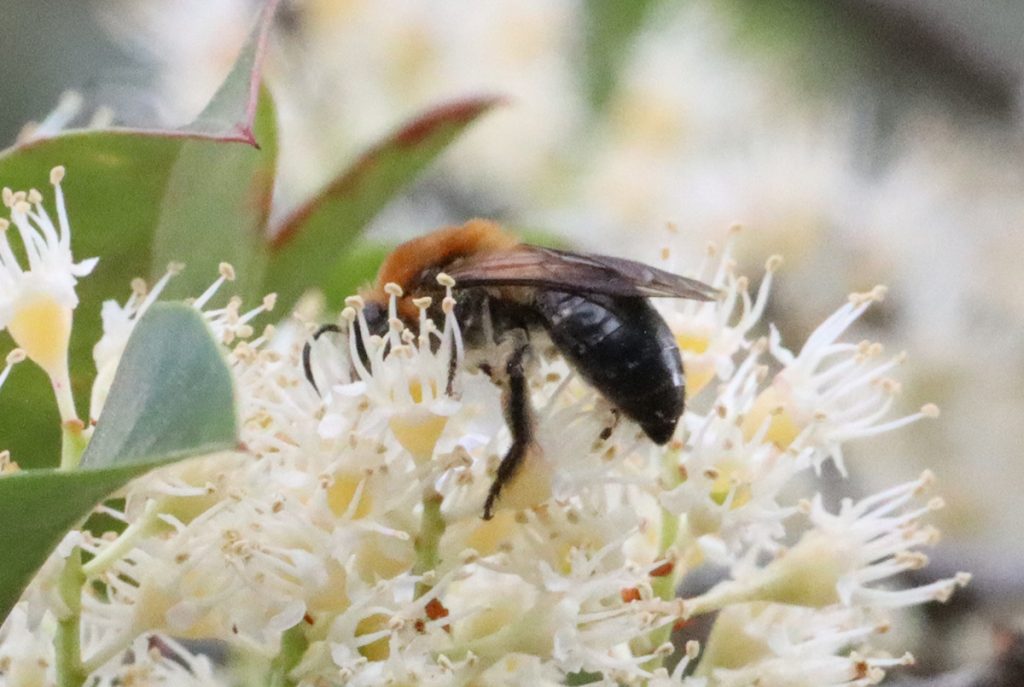
Sandhills cellophane bee (Colletes ultravalidus)
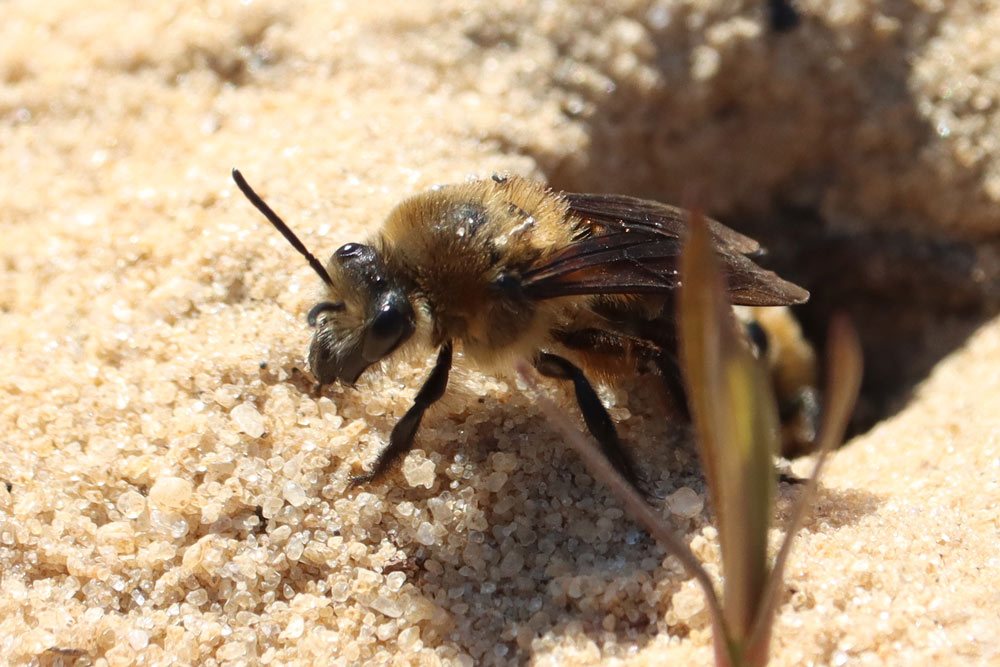
This bee was first described in 2016 and has only been observed in a handful of locations in north Florida, and one location in Mississippi. One reason people don’t see much of the bee is that it only flies for a short time, and keeps to a specific habitat.
Its few observations have been on or near blueberry bushes, specifically bushes in sandhill habitats near cypress wetland areas. A blueberry relative, climbing fetterbush, climbs up cypress trees, and blueberry bushes thrive near the edge of the ponds. The sand there is too wet for ground-nesting bees to excavate, and this bee needs deep, open sand to make a nest.
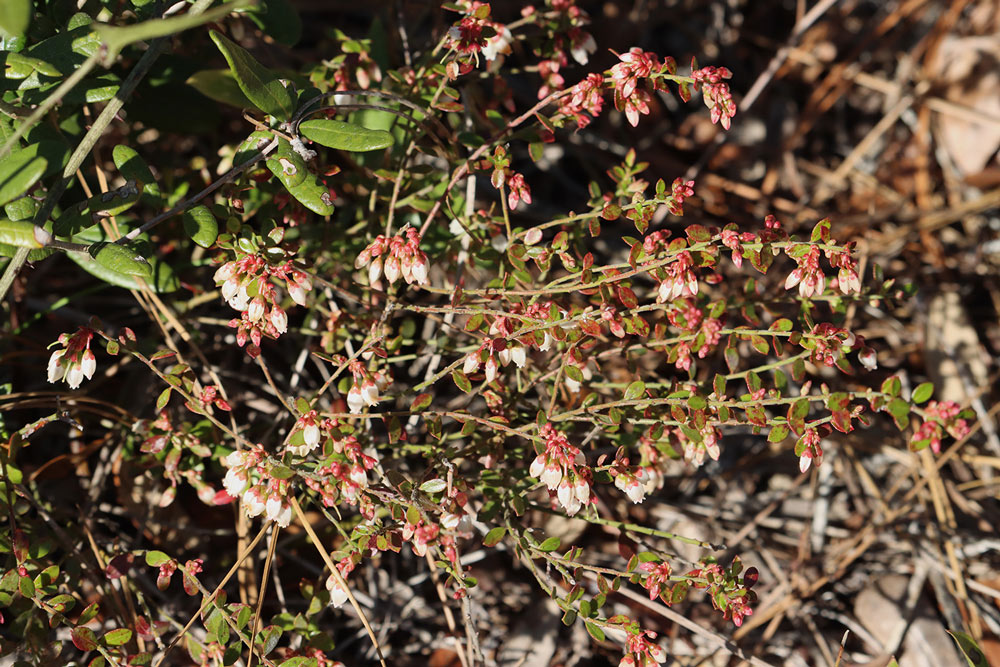
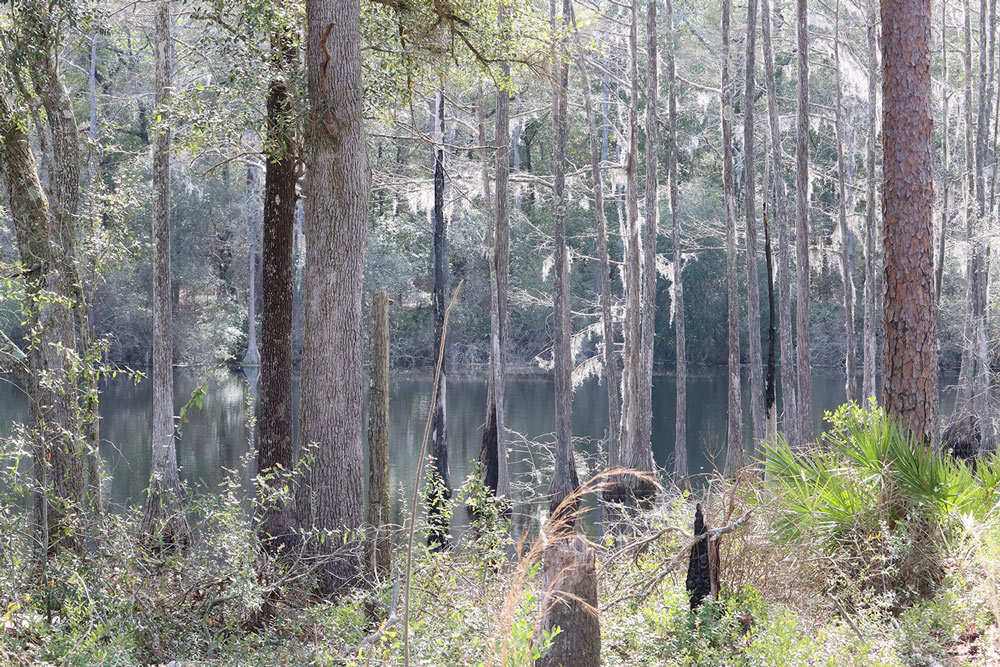
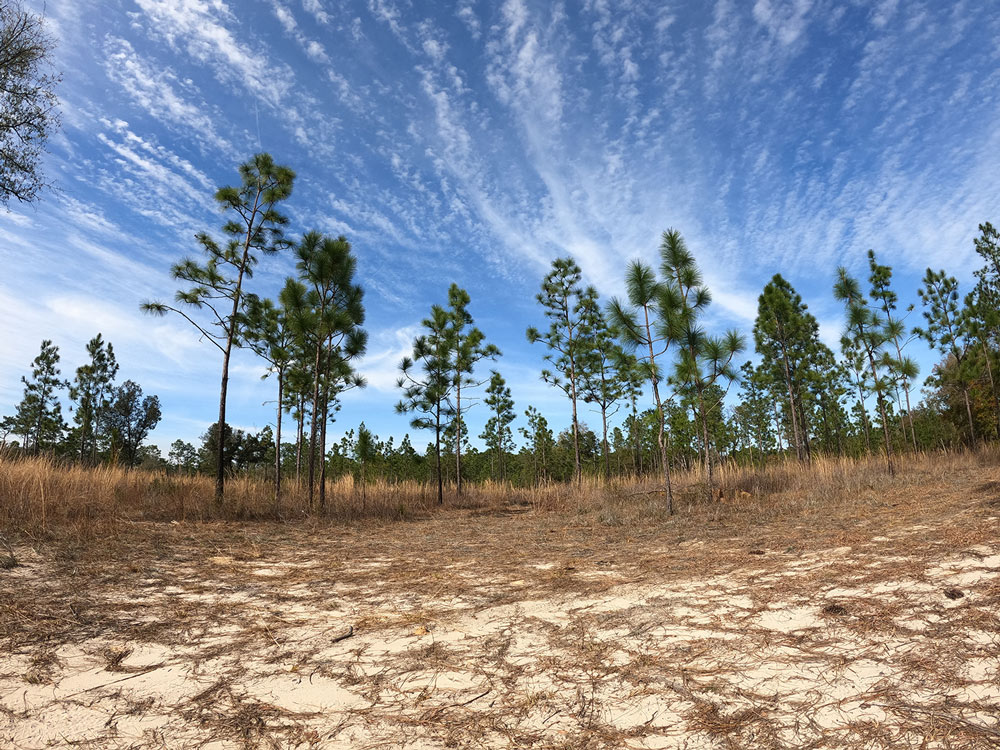
Blueberries in north Florida bloom in February and March, and that’s when you would see this bee flying. Males also fly in December, making it one of the few native bees in the air in winter. The best way to find the bees themselves is to find their nests on sandhills. They are about three inches across, with an opening about a centimeter across (yes, I mixed metric and standard). If you see the bee, upload your photos to iNaturalist to add observations and help researchers track the species.
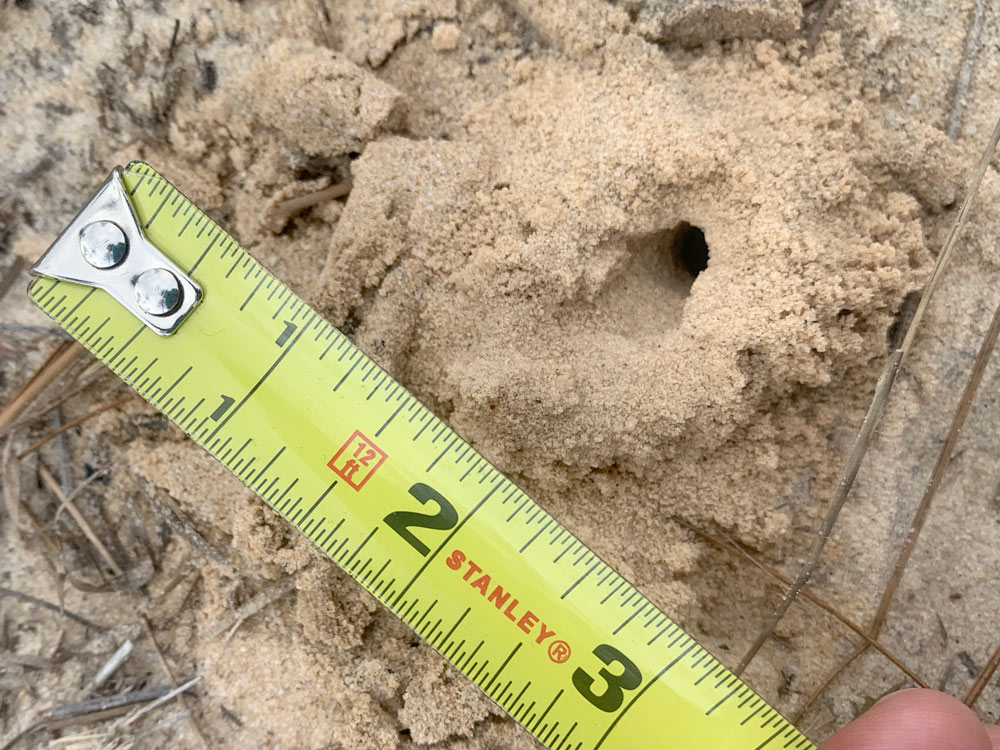
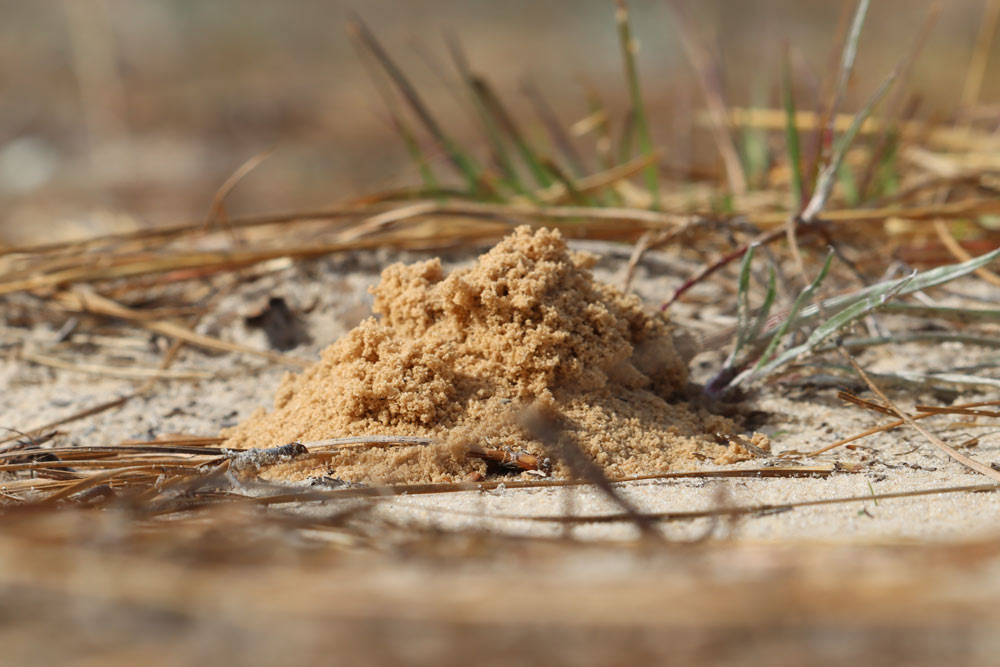
Many of the photos above come from the Backyard Blog. WFSU Ecology producer Rob Diaz de Villegas has been chronicling the plants and animals in his yard since 2018, paying close attention to insects.
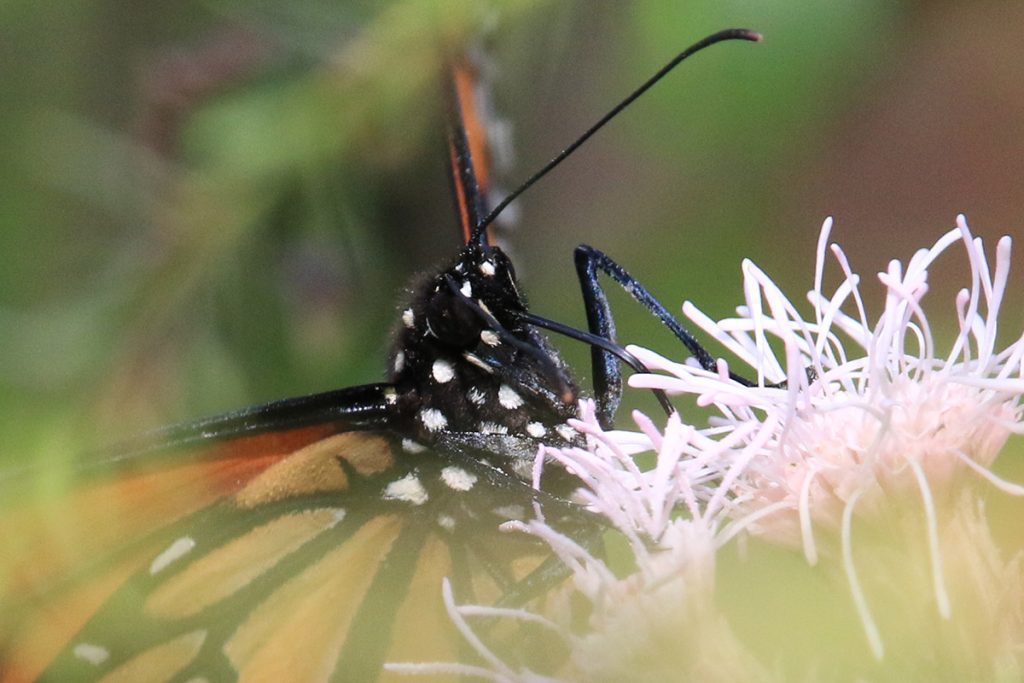
Dig Deeper into Backyard Ecology
What can we do to invite butterflies, birds, and other wildlife into our yards? And what about the flora and fauna that makes its way into our yards; the weeds, insects, and other critters that create the home ecosystem? WFSU Ecology Blog takes a closer look.

